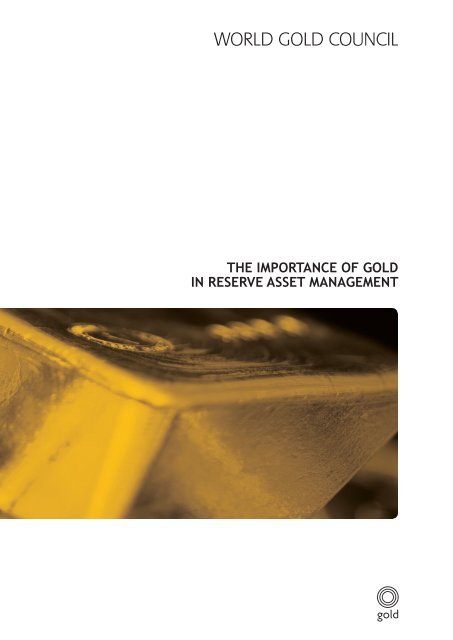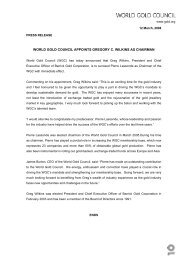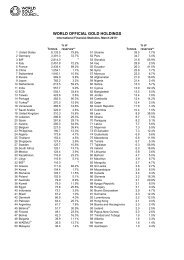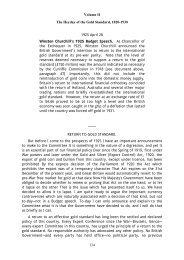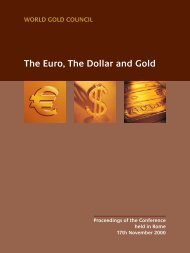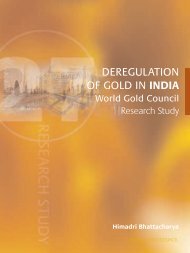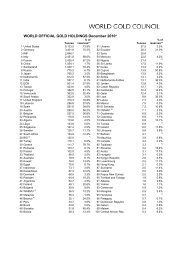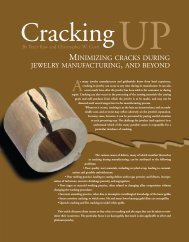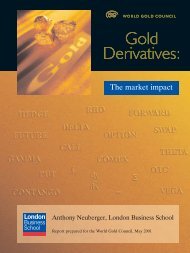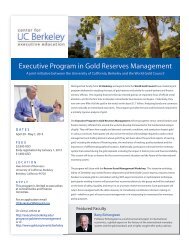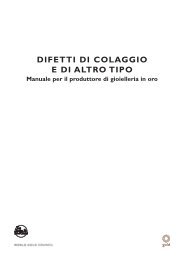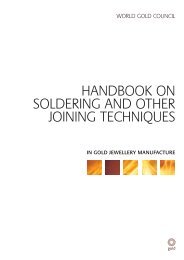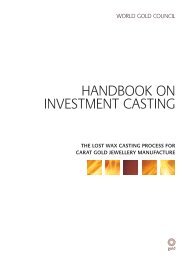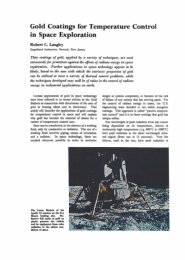the importance of gold in reserve asset management - World Gold ...
the importance of gold in reserve asset management - World Gold ...
the importance of gold in reserve asset management - World Gold ...
Create successful ePaper yourself
Turn your PDF publications into a flip-book with our unique Google optimized e-Paper software.
THE IMPORTANCE OF GOLD<br />
IN RESERVE ASSET MANAGEMENT
About The <strong>World</strong> <strong>Gold</strong> Council<br />
The <strong>World</strong> <strong>Gold</strong> Council’s mission is to stimulate<br />
and susta<strong>in</strong> <strong>the</strong> demand for <strong>gold</strong> and to create<br />
endur<strong>in</strong>g value for its stakeholders. The organisation<br />
represents <strong>the</strong> world’s lead<strong>in</strong>g <strong>gold</strong> m<strong>in</strong><strong>in</strong>g<br />
companies, who produce more than 60% <strong>of</strong> <strong>the</strong><br />
world’s annual <strong>gold</strong> production <strong>in</strong> a responsible<br />
manner and whose Chairmen and CEOs form <strong>the</strong><br />
Board <strong>of</strong> <strong>the</strong> <strong>World</strong> <strong>Gold</strong> Council (WGC).<br />
As <strong>the</strong> <strong>gold</strong> <strong>in</strong>dustry’s key market development<br />
body, WGC works with multiple partners to create<br />
structural shifts <strong>in</strong> demand and to promote <strong>the</strong><br />
use <strong>of</strong> <strong>gold</strong> <strong>in</strong> all its forms; as an <strong>in</strong>vestment by<br />
open<strong>in</strong>g new market channels and mak<strong>in</strong>g <strong>gold</strong>’s<br />
wealth preservation qualities better understood;<br />
<strong>in</strong> jewellery through <strong>the</strong> development <strong>of</strong> <strong>the</strong> premium<br />
market and <strong>the</strong> protection <strong>of</strong> <strong>the</strong> mass market; <strong>in</strong><br />
<strong>in</strong>dustry through <strong>the</strong> development <strong>of</strong> <strong>the</strong> electronics<br />
market and <strong>the</strong> support <strong>of</strong> emerg<strong>in</strong>g technologies<br />
and <strong>in</strong> government affairs through engagement <strong>in</strong><br />
macro-economic policy issues, lower<strong>in</strong>g regulatory<br />
barriers to <strong>gold</strong> ownership and <strong>the</strong> promotion <strong>of</strong><br />
<strong>gold</strong> as a <strong>reserve</strong> <strong>asset</strong>.<br />
The WGC is a commercially-driven organisation and<br />
is focussed on creat<strong>in</strong>g a new prom<strong>in</strong>ence for <strong>gold</strong>.<br />
It has its headquarters <strong>in</strong> London and operations<br />
<strong>in</strong> <strong>the</strong> key <strong>gold</strong> demand centres <strong>of</strong> India, Ch<strong>in</strong>a,<br />
<strong>the</strong> Middle East and United States. The WGC is<br />
<strong>the</strong> lead<strong>in</strong>g source <strong>of</strong> <strong>in</strong>dependent research and<br />
knowledge on <strong>the</strong> <strong>in</strong>ternational <strong>gold</strong> market and<br />
on <strong>gold</strong>’s role <strong>in</strong> meet<strong>in</strong>g <strong>the</strong> social and economic<br />
demands <strong>of</strong> society.
The <strong>importance</strong> <strong>of</strong> <strong>gold</strong> <strong>in</strong> <strong>reserve</strong> <strong>asset</strong> <strong>management</strong><br />
<br />
Contents<br />
Context 2<br />
Executive Summary 3<br />
The Case for <strong>Gold</strong> as a Reserve Asset 4<br />
g Strategic <strong>asset</strong> allocation <strong>in</strong> foreign<br />
exchange <strong>reserve</strong>s 4<br />
g <strong>Gold</strong> as a hedge aga<strong>in</strong>st current<br />
macro-economic risks 9<br />
g <strong>Gold</strong> and liquidity 12<br />
Fundamentals <strong>of</strong> <strong>the</strong> <strong>Gold</strong> Market 16<br />
g Demand 16<br />
g Supply 19<br />
Trad<strong>in</strong>g and Stor<strong>in</strong>g <strong>Gold</strong> 23<br />
Appendix: Case Study on Bangko Sentral ng<br />
Pilip<strong>in</strong>as (BSP, <strong>the</strong> Philipp<strong>in</strong>es central bank) 25
The <strong>importance</strong> <strong>of</strong> <strong>gold</strong> <strong>in</strong> <strong>reserve</strong> <strong>asset</strong> <strong>management</strong><br />
Context<br />
This report is part <strong>of</strong> a series <strong>of</strong> occasional papers<br />
published by <strong>the</strong> <strong>World</strong> <strong>Gold</strong> Council’s Government<br />
Affairs team. Previous papers have looked at <strong>the</strong><br />
history <strong>of</strong> <strong>gold</strong> as a <strong>reserve</strong> <strong>asset</strong> and <strong>the</strong> recent<br />
evolution <strong>in</strong> central banks’ attitudes towards <strong>gold</strong>.<br />
This report exam<strong>in</strong>es how <strong>gold</strong> can help emerg<strong>in</strong>g<br />
and develop<strong>in</strong>g economies’ central banks meet<br />
<strong>the</strong>ir foreign <strong>reserve</strong> <strong>management</strong> objectives. It<br />
looks at <strong>gold</strong> <strong>in</strong> three contexts: as a strategic <strong>asset</strong><br />
and <strong>in</strong> <strong>the</strong> maximisation <strong>of</strong> risk-adjusted returns, as<br />
a hedge aga<strong>in</strong>st current macro-economic risks and<br />
as a liquidity provider <strong>in</strong> times <strong>of</strong> market distress.<br />
The analysis and f<strong>in</strong>d<strong>in</strong>g from <strong>the</strong>se reports are<br />
actively used <strong>in</strong> our discussions with central banks<br />
around <strong>the</strong> world. Future papers <strong>in</strong> this series will<br />
look <strong>in</strong> more detail at how <strong>gold</strong> performs vis-à-vis<br />
o<strong>the</strong>r <strong>reserve</strong> <strong>asset</strong>s <strong>in</strong> help<strong>in</strong>g central banks meet<br />
<strong>the</strong>ir <strong>reserve</strong> objectives.<br />
For more <strong>in</strong>formation, please contact:<br />
Natalie Dempster<br />
Director, Government Affairs<br />
natalie.dempster@<strong>gold</strong>.org<br />
George Mill<strong>in</strong>g-Stanley<br />
Manag<strong>in</strong>g Director, Government Affairs<br />
george.mill<strong>in</strong>g-stanley@<strong>gold</strong>.org
The <strong>importance</strong> <strong>of</strong> <strong>gold</strong> <strong>in</strong> <strong>reserve</strong> <strong>asset</strong> <strong>management</strong><br />
<br />
The <strong>importance</strong> <strong>of</strong> <strong>gold</strong> <strong>in</strong> <strong>reserve</strong> <strong>asset</strong> <strong>management</strong><br />
Executive Summary<br />
This report exam<strong>in</strong>es how <strong>gold</strong> can help a central<br />
bank meet its foreign <strong>reserve</strong> <strong>management</strong> objectives.<br />
It also expla<strong>in</strong>s how <strong>the</strong> <strong>gold</strong> market works, both <strong>in</strong><br />
terms <strong>of</strong> <strong>the</strong> fundamentals <strong>of</strong> demand and supply,<br />
and <strong>the</strong> trad<strong>in</strong>g and vault<strong>in</strong>g <strong>of</strong> <strong>gold</strong>.<br />
In <strong>the</strong> section on “The Case for <strong>Gold</strong> as a Reserve<br />
Asset” looks at <strong>gold</strong> <strong>in</strong> three contexts: strategic <strong>asset</strong><br />
allocation and <strong>the</strong> maximisation <strong>of</strong> risk-adjusted<br />
returns <strong>in</strong> <strong>the</strong> <strong>in</strong>vestment portfolio; as a tactical<br />
overlay to hedge aga<strong>in</strong>st current global macroeconomic<br />
risks; and as a high-quality liquid <strong>asset</strong><br />
<strong>in</strong> periods <strong>of</strong> distress, <strong>the</strong> time when central banks<br />
most need <strong>the</strong>ir <strong>reserve</strong>s.<br />
Portfolio optimiser models are used to show that <strong>the</strong><br />
efficient frontier <strong>of</strong> a typical develop<strong>in</strong>g or emerg<strong>in</strong>g<br />
market central bank can be enhanced by add<strong>in</strong>g<br />
<strong>gold</strong>. How much <strong>gold</strong> depends on a central bank’s<br />
risk appetite: an allocation to <strong>gold</strong> <strong>of</strong> between 2.4<br />
and 8.5% is optimal for a bank with around a 5% risk<br />
tolerance. At a risk tolerance <strong>of</strong> 8.3%, <strong>the</strong> allocation<br />
to <strong>gold</strong> <strong>in</strong>creases to 29%.<br />
The results are not <strong>in</strong>tended as a strategic <strong>asset</strong><br />
allocation recommendation for any specific central<br />
bank, not least because central banks’ actual<br />
portfolios will differ from <strong>the</strong> one used <strong>in</strong> <strong>the</strong><br />
illustration, as will <strong>the</strong>ir risk and return expectations,<br />
and constra<strong>in</strong>ts. The allocations <strong>of</strong> emerg<strong>in</strong>g and<br />
develop<strong>in</strong>g countries – that already hold <strong>gold</strong> <strong>in</strong><br />
<strong>the</strong>ir portfolios – vary widely, <strong>in</strong> practice, because <strong>of</strong><br />
<strong>the</strong>se and o<strong>the</strong>r factors. The appropriate allocation to<br />
<strong>gold</strong> for a central bank will depend on its <strong>in</strong>vestment<br />
policy objectives and guidel<strong>in</strong>es, its exist<strong>in</strong>g <strong>asset</strong><br />
mix, its risk tolerance, its tactical view on market<br />
trends and its liquidity requirements. Reserve <strong>asset</strong><br />
<strong>management</strong> policies also have to respond to<br />
political considerations and <strong>the</strong> cultural aff<strong>in</strong>ity to<br />
<strong>gold</strong> with<strong>in</strong> a country.<br />
Current global macro-economic risks, such as <strong>the</strong><br />
European sovereign debt crisis and strong money<br />
supply growth argue for an additional tactical overlay<br />
to <strong>gold</strong> <strong>in</strong> <strong>reserve</strong>s. The <strong>in</strong>vestment guidel<strong>in</strong>es <strong>of</strong><br />
emerg<strong>in</strong>g market and develop<strong>in</strong>g country central<br />
banks <strong>of</strong>ten limit <strong>reserve</strong>s to be<strong>in</strong>g <strong>in</strong>vested <strong>in</strong> a few<br />
key <strong>asset</strong> classes, such as deposits, high quality<br />
sovereign debt and quasi-sovereign bonds and SDRs.<br />
A sovereign debt downgrade to below <strong>in</strong>vestment<br />
grade reduces <strong>the</strong> pool <strong>of</strong> eligible <strong>in</strong>vestments for<br />
<strong>the</strong>se central banks, while contagion risks lowers <strong>the</strong><br />
attractiveness <strong>of</strong> similar <strong>asset</strong>s. <strong>Gold</strong>, which bears<br />
no counterparty or credit risk, and is a permissible<br />
<strong>reserve</strong> <strong>asset</strong> <strong>in</strong> practically every central bank <strong>in</strong> <strong>the</strong><br />
world, becomes especially attractive <strong>in</strong> <strong>the</strong> current<br />
environment. <strong>Gold</strong> can also help hedge aga<strong>in</strong>st <strong>the</strong><br />
risks associated with strong money supply growth.<br />
The 2007/2009 f<strong>in</strong>ancial crisis clearly demonstrated<br />
<strong>the</strong> challenges <strong>of</strong> runn<strong>in</strong>g a liquidity portfolio. Many<br />
markets, that <strong>reserve</strong> managers had assumed to be<br />
deep and liquid, proved to be <strong>the</strong> exact opposite<br />
and <strong>asset</strong>s could only be sold at a large discount.<br />
The <strong>gold</strong> market rema<strong>in</strong>ed liquid throughout <strong>the</strong><br />
f<strong>in</strong>ancial crisis, even at <strong>the</strong> height <strong>of</strong> liquidity stra<strong>in</strong>s<br />
<strong>in</strong> o<strong>the</strong>r markets. This reflects <strong>the</strong> depth and breadth<br />
<strong>of</strong> <strong>the</strong> <strong>gold</strong> market, as well as <strong>the</strong> flight-to-quality<br />
tendencies exhibited by some <strong>in</strong>vestors.<br />
Because <strong>gold</strong> is virtually <strong>in</strong>destructible, almost all <strong>of</strong> <strong>the</strong><br />
<strong>gold</strong> that has ever been m<strong>in</strong>ed still exists: <strong>in</strong> <strong>the</strong> fixed<strong>in</strong>come<br />
market <strong>gold</strong> would be equivalent to a bond that<br />
never matures. Perhaps <strong>the</strong> best proxy to outstand<strong>in</strong>g<br />
bond issuance for <strong>gold</strong> is <strong>the</strong> comb<strong>in</strong>ed value <strong>of</strong> <strong>gold</strong><br />
held <strong>in</strong> private bullion stocks and <strong>in</strong> <strong>the</strong> <strong>of</strong>ficial sector.<br />
The <strong>gold</strong> market is larger, on this basis, than each <strong>of</strong><br />
<strong>the</strong> Eurozone bond markets, save Italy. And we estimate<br />
daily turnover volumes <strong>in</strong> <strong>the</strong> <strong>gold</strong> market to be larger<br />
than UK Gilt and German Bund markets.<br />
Hav<strong>in</strong>g made a clear case for <strong>gold</strong> as a <strong>reserve</strong><br />
<strong>asset</strong>, <strong>the</strong> report <strong>the</strong>n exam<strong>in</strong>es how <strong>the</strong> <strong>gold</strong> market<br />
works <strong>in</strong> terms <strong>of</strong> <strong>the</strong> fundamentals <strong>of</strong> demand<br />
and supply, and how <strong>the</strong>se underp<strong>in</strong> <strong>gold</strong>’s key<br />
<strong>in</strong>vestment characteristics, such as its lack <strong>of</strong><br />
correlation with o<strong>the</strong>r <strong>reserve</strong> <strong>asset</strong>s and its counter<br />
cyclical behavior. In <strong>the</strong> f<strong>in</strong>al section, we expla<strong>in</strong> <strong>the</strong><br />
various different ways that a central bank can buy,<br />
sell and store its <strong>gold</strong>.<br />
A case study on Bangko Sentral ng Pilip<strong>in</strong>as (BSP,<br />
<strong>the</strong> Philipp<strong>in</strong>es central bank) provides an example <strong>of</strong><br />
how an emerg<strong>in</strong>g market central bank has handled<br />
its <strong>gold</strong> <strong>reserve</strong>s over <strong>the</strong> years.
The <strong>importance</strong> <strong>of</strong> <strong>gold</strong> <strong>in</strong> <strong>reserve</strong> <strong>asset</strong> <strong>management</strong><br />
The Case for <strong>Gold</strong> as a<br />
Reserve Asset<br />
Strategic <strong>asset</strong> allocation <strong>in</strong> foreign<br />
exchange <strong>reserve</strong>s<br />
Strategic <strong>asset</strong> allocation def<strong>in</strong>es <strong>the</strong> long-term<br />
proportion <strong>of</strong> <strong>in</strong>dividual <strong>asset</strong>s that should be held <strong>in</strong><br />
a portfolio <strong>in</strong> order to maximise risk-adjusted returns.<br />
In practice, a central bank’s portfolio will diverge<br />
from this, <strong>in</strong> some cases substantially, <strong>in</strong> order<br />
to accommodate any constra<strong>in</strong>t imposed on <strong>the</strong><br />
portfolio by <strong>the</strong> bank’s <strong>in</strong>vestment guidel<strong>in</strong>es, to take<br />
<strong>in</strong>to consideration <strong>the</strong> bank’s tactical views and to<br />
meet <strong>the</strong> bank’s liquidity objectives. However, for <strong>the</strong><br />
purposes <strong>of</strong> this analysis we are solely concerned<br />
with <strong>the</strong> underly<strong>in</strong>g strategic allocation.<br />
In this section we use a portfolio optimiser to exam<strong>in</strong>e<br />
whe<strong>the</strong>r add<strong>in</strong>g <strong>gold</strong> to <strong>the</strong> portfolio <strong>of</strong> a “typical”<br />
emerg<strong>in</strong>g or develop<strong>in</strong>g economy’s central bank<br />
can expand <strong>the</strong> efficient frontier and enhance riskadjusted<br />
returns. We chose emerg<strong>in</strong>g and develop<strong>in</strong>g<br />
economies, as <strong>the</strong> portfolios <strong>of</strong> many advanced<br />
economy central banks are already heavily skewed<br />
towards <strong>gold</strong> as a legacy <strong>of</strong> <strong>the</strong> <strong>gold</strong> standard and<br />
Bretton Woods days when fiat currencies were<br />
backed by or underp<strong>in</strong>ned by <strong>gold</strong>.<br />
The data<br />
The first step <strong>in</strong> any analysis is to def<strong>in</strong>e <strong>the</strong> “typical”<br />
portfolio. Currency composition <strong>of</strong> <strong>of</strong>ficial foreign<br />
exchange <strong>reserve</strong>s (COFER) data from <strong>the</strong> IMF serves<br />
a useful start<strong>in</strong>g po<strong>in</strong>t, as <strong>the</strong>y provide a breakdown<br />
<strong>of</strong> emerg<strong>in</strong>g and develop<strong>in</strong>g countries’ foreign<br />
<strong>reserve</strong>s by currency. In <strong>the</strong> f<strong>in</strong>al quarter <strong>of</strong> 2009,<br />
58% <strong>of</strong> <strong>the</strong> allocated <strong>reserve</strong>s <strong>of</strong> those countries<br />
which reported were held <strong>in</strong> dollar denom<strong>in</strong>ated<br />
<strong>asset</strong>s, 31% <strong>in</strong> euro-denom<strong>in</strong>ated <strong>asset</strong>s, 6% <strong>in</strong><br />
sterl<strong>in</strong>g-based <strong>asset</strong>s, 2% <strong>in</strong> yen-based <strong>asset</strong>s and<br />
3% <strong>in</strong> o<strong>the</strong>r currencies.<br />
After determ<strong>in</strong><strong>in</strong>g which currencies are commonly<br />
used <strong>in</strong> <strong>reserve</strong> portfolios, we identified <strong>the</strong> various<br />
<strong>asset</strong> classes with<strong>in</strong> each currency that best matched<br />
<strong>the</strong> actual <strong>in</strong>vestment practices <strong>of</strong> develop<strong>in</strong>g and<br />
emerg<strong>in</strong>g market central banks. This was based on<br />
a variety <strong>of</strong> sources, <strong>in</strong>clud<strong>in</strong>g US Treasury data on<br />
hold<strong>in</strong>gs <strong>of</strong> US securities by foreign <strong>of</strong>ficial <strong>in</strong>stitutions,<br />
<strong>the</strong> published <strong>in</strong>vestment guidel<strong>in</strong>es <strong>of</strong> central banks<br />
and our discussions with <strong>in</strong>dustry experts.<br />
Currency Figure 1: compostion Currency <strong>of</strong> compostion <strong>of</strong>ficial foreign <strong>of</strong> exchange <strong>of</strong>ficial foreign <strong>reserve</strong>s, exchange allocated <strong>reserve</strong>s (% <strong>of</strong> to<br />
<strong>reserve</strong>s, allocated <strong>reserve</strong>s (% <strong>of</strong> total, Q4 2009)<br />
Japanese yen<br />
2%<br />
Source:<br />
Source:<br />
IMF<br />
IMF<br />
Euros<br />
31%<br />
Pounds sterl<strong>in</strong>g<br />
6%<br />
O<strong>the</strong>r<br />
3%<br />
US dollars<br />
58%<br />
Because we would be us<strong>in</strong>g historical data as <strong>in</strong>puts<br />
for <strong>the</strong> expected real returns and risk pr<strong>of</strong>iles, we<br />
also needed a sufficiently long time series for each<br />
<strong>asset</strong> class to avoid any period dependency effects.<br />
In o<strong>the</strong>r words <strong>the</strong> period should not, to <strong>the</strong> extent<br />
possible, be unduly bearish or bullish for any one<br />
<strong>asset</strong> class. This required ref<strong>in</strong><strong>in</strong>g <strong>the</strong> list fur<strong>the</strong>r to<br />
take account <strong>of</strong> historical data availability. The data<br />
sets we eventually chose, along with <strong>the</strong>ir real returns<br />
and standard deviations for <strong>the</strong> past fifteen years, are<br />
shown <strong>in</strong> table 1. All <strong>the</strong> data are displayed <strong>in</strong> dollars<br />
on an unhedged basis and all fur<strong>the</strong>r calculations<br />
are made on this basis.<br />
Table 1: Selected <strong>asset</strong>s*, Jan 1994-April 2010<br />
Real<br />
annualised<br />
monthly<br />
returns (%)<br />
Standard<br />
deviation<br />
(%)<br />
BarCap US Aggregate Treasury Index 3.4 5.2<br />
BarCap US Aggregate Agencies Index 3.4 4.2<br />
JP Morgan German Traded Index 4.7 10.7<br />
JP Morgan Japan Traded Index 2.3 12.3<br />
JP Morgan UK Traded Index 4.3 9.2<br />
<strong>Gold</strong> (US$/oz) 5.6 15.2<br />
*Total Return Indices, except <strong>gold</strong>.
The <strong>importance</strong> <strong>of</strong> <strong>gold</strong> <strong>in</strong> <strong>reserve</strong> <strong>asset</strong> <strong>management</strong><br />
<br />
At first glance <strong>the</strong> results do not seem to make an<br />
especially compell<strong>in</strong>g case for <strong>gold</strong> as a <strong>reserve</strong><br />
<strong>asset</strong>: <strong>gold</strong> has <strong>the</strong> highest annualised monthly<br />
return, but it also has <strong>the</strong> highest risk, and as central<br />
banks are especially risk averse, <strong>the</strong> latter is likely<br />
to be given <strong>the</strong> most weight. In addition, one could<br />
argue that <strong>the</strong> period under review – 1994 to 2010<br />
- was particularly propitious for <strong>gold</strong> (<strong>the</strong> lack <strong>of</strong> a<br />
sufficiently long time series for some <strong>of</strong> <strong>the</strong> o<strong>the</strong>r data<br />
prevented us from beg<strong>in</strong>n<strong>in</strong>g <strong>the</strong> analysis earlier)<br />
as it encompassed <strong>the</strong> long <strong>gold</strong> bull market that<br />
began <strong>in</strong> 2001 (we address this po<strong>in</strong>t under “<strong>in</strong>puts<br />
and constra<strong>in</strong>ts”).<br />
But returns and volatility are not all that matter for<br />
risk-adjusted returns. The way <strong>the</strong> <strong>asset</strong>s <strong>in</strong>teract with<br />
one ano<strong>the</strong>r, or <strong>the</strong> co-variance, also matters. On this<br />
basis, <strong>gold</strong> stands out as <strong>the</strong> most effective portfolio<br />
diversifier, display<strong>in</strong>g <strong>the</strong> lowest average correlation<br />
with each <strong>of</strong> <strong>the</strong> o<strong>the</strong>r <strong>asset</strong>s. This reflects <strong>the</strong> unique<br />
drivers <strong>of</strong> <strong>the</strong> <strong>gold</strong> price, described <strong>in</strong> detail under<br />
“Fundamentals <strong>of</strong> <strong>the</strong> <strong>Gold</strong> Market”.<br />
The optimiser<br />
The next stage was to use a portfolio optimiser to<br />
assess whe<strong>the</strong>r <strong>gold</strong>’s low co-variance with <strong>the</strong> o<strong>the</strong>r<br />
<strong>asset</strong>s would <strong>of</strong>fset <strong>the</strong> impact <strong>of</strong> its relatively high<br />
volatility on <strong>the</strong> portfolio’s performance. We used<br />
New Frontier Advisors’ patented portfolio optimiser,<br />
which pioneered a technique called re-sampled<br />
efficiency optimisation (RE), to conduct <strong>the</strong> analysis.<br />
The RE optimiser has been acknowledged by Harry<br />
Markowitz, founder <strong>of</strong> Modern Portfolio Theory, to<br />
be more effective and robust than classical meanvariance<br />
optimisation. The mean-variance technique<br />
<strong>of</strong> portfolio optimisation pioneered by Markowitz,<br />
while <strong>the</strong>oretically groundbreak<strong>in</strong>g, is limited <strong>in</strong> its<br />
practical use. If you are 100% certa<strong>in</strong> <strong>of</strong> your riskreturn<br />
estimates, <strong>the</strong>n classical mean-variance<br />
optimisation will provide <strong>the</strong> best solution. However,<br />
such <strong>in</strong>put certa<strong>in</strong>ties do not exist <strong>in</strong> practice. In RE<br />
optimisation, <strong>the</strong> optimal portfolio <strong>in</strong>stead represents<br />
<strong>the</strong> average <strong>of</strong> a large number <strong>of</strong> simulated portfolios<br />
around <strong>the</strong> projected risk and return <strong>in</strong>puts. While<br />
<strong>the</strong> expected efficient frontier will tend to be<br />
slightly lower than estimated by classical meanvariance,<br />
<strong>the</strong> level <strong>of</strong> confidence that one can have<br />
<strong>in</strong> <strong>the</strong> efficient frontier is improved. The result<strong>in</strong>g<br />
process is more stable and produces more reliable<br />
optimal portfolios.<br />
Inputs and constra<strong>in</strong>ts<br />
For <strong>the</strong> expected real returns and standard<br />
deviations we used <strong>the</strong> long-run historical averages<br />
shown <strong>in</strong> table 1, as is normal practice <strong>in</strong> <strong>the</strong>se type<br />
<strong>of</strong> studies. But we made one exception. In order to<br />
be as conservative as possible with respect to <strong>gold</strong><br />
and avoid any criticism <strong>of</strong> <strong>the</strong> study hav<strong>in</strong>g been<br />
conducted over a period that encompassed a long<br />
bull market, we lowered <strong>gold</strong>’s expected real return<br />
to 4%, <strong>in</strong> keep<strong>in</strong>g with its performance s<strong>in</strong>ce 1974.<br />
We chose 1974 as <strong>the</strong> <strong>in</strong>itial perturbations <strong>in</strong> <strong>the</strong> <strong>gold</strong><br />
price follow<strong>in</strong>g Nixon’s closure <strong>of</strong> <strong>the</strong> <strong>gold</strong> w<strong>in</strong>dow <strong>in</strong><br />
1971 would have been worked through by <strong>the</strong>n.<br />
Table 2: Correlations, based on monthly returns between Jan1994 and April 2010.<br />
US Treasuries US Agencies German bunds Japanese Govt.<br />
bonds<br />
UK Gilts<br />
<strong>Gold</strong><br />
US Treasuries 1.000 0.922 0.471 0.287 0.422 0.203<br />
US Agencies 0.922 1.000 0.465 0.243 0.435 0.214<br />
German bunds 0.471 0.465 1.000 0.451 0.667 0.421<br />
Japanese Govt. bonds 0.287 0.243 0.451 1.000 0.235 0.250<br />
UK Gilts 0.422 0.435 0.667 0.235 1.000 0.283<br />
<strong>Gold</strong> 0.203 0.214 0.421 0.250 0.283 1.000<br />
Source: NFA
The <strong>importance</strong> <strong>of</strong> <strong>gold</strong> <strong>in</strong> <strong>reserve</strong> <strong>asset</strong> <strong>management</strong><br />
The <strong>Gold</strong> Price (London PM fix) dollars per ounce<br />
Figure 2: The <strong>gold</strong> price (London PM fix) dollars per ounce<br />
Tonnes<br />
1400<br />
1200<br />
1000<br />
800<br />
600<br />
400<br />
200<br />
0<br />
Jan 71 Jan 74 Jan 77 Jan 80 Jan 83 Jan 86 Jan 89 Jan 92 Jan 95 Jan 98 Jan 01 Jan 04 Jan 07 Jan 10<br />
Source: Bloomberg<br />
The second constra<strong>in</strong>t we imposed on <strong>the</strong> optimiser<br />
was to cap <strong>the</strong> allocation to US Agency bonds to<br />
25%. We did this because prelim<strong>in</strong>ary optimisation<br />
runs had resulted <strong>in</strong> exceptionally large allocations<br />
to US Agencies relative to US Treasuries, based on<br />
<strong>the</strong> fact that <strong>the</strong> two <strong>asset</strong>s had <strong>the</strong> same level <strong>of</strong><br />
return but Agencies had a lower standard deviation.<br />
However, this was <strong>in</strong>consistent with what we knew<br />
about central bank’s actual allocations to <strong>the</strong>se <strong>asset</strong>s<br />
and <strong>the</strong> amount <strong>of</strong> each type <strong>of</strong> bond <strong>in</strong> issuance. 1<br />
The results<br />
The optimiser <strong>the</strong>n ran 1000 simulations around<br />
<strong>the</strong>se <strong>in</strong>puts. The efficient frontier and optimal set<br />
<strong>of</strong> portfolios for each level <strong>of</strong> risk are shown <strong>in</strong><br />
figure 3. The coloured chart depicts <strong>the</strong> allocations<br />
<strong>of</strong> each <strong>asset</strong> class required to achieve <strong>the</strong> o<strong>the</strong>r<br />
optimal portfolios on <strong>the</strong> efficient frontier, which<br />
vary accord<strong>in</strong>g to risk appetite. Some selected<br />
portfolios are shown <strong>in</strong> table 3. The allocation to<br />
<strong>gold</strong> climbs steadily as risk tolerance <strong>in</strong>creases.<br />
For example, at an expected annualised volatility <strong>of</strong><br />
8.3% <strong>the</strong> allocation to <strong>gold</strong> rises to 29%. However,<br />
as we assume central banks are typically far less<br />
risk tolerant, <strong>the</strong> actual stategic allocation to <strong>gold</strong><br />
suggested by <strong>the</strong> optimiser for a central bank would<br />
be much lower. For a risk tolerance <strong>of</strong> around 5%,<br />
<strong>the</strong> allocation to <strong>gold</strong> ranges between 2.4-8.5%. The<br />
RE optimiser performs ano<strong>the</strong>r function, which is to<br />
assess whe<strong>the</strong>r <strong>the</strong> allocation to <strong>gold</strong> is statistically<br />
significant: it calculates this to be so at each and<br />
every risk level.<br />
The results are not <strong>in</strong>tended as a strategic <strong>asset</strong><br />
allocation recommendation for any <strong>in</strong>dividual central<br />
bank, not least because central banks’ actual<br />
portfolios will differ from <strong>the</strong> one <strong>in</strong> <strong>the</strong> illustration, as<br />
will <strong>the</strong>ir risk and return expectations, and constra<strong>in</strong>ts.<br />
For example, a bank may wish to lower <strong>the</strong> proportion<br />
<strong>of</strong> dollar de-nom<strong>in</strong>ated <strong>asset</strong>s due to concerns about<br />
future dollar weakness, or its allocation to Bunds due<br />
to <strong>the</strong> European sovereign debt crisis. In addition,<br />
we have used a “base currency” approach, where<br />
<strong>the</strong> currency and <strong>in</strong>dividual <strong>asset</strong> compositions are<br />
determ<strong>in</strong>ed simultaneously, whereas some central<br />
banks may pre-determ<strong>in</strong>e <strong>the</strong> amount <strong>of</strong> each<br />
currency <strong>the</strong>y want to hold first, <strong>the</strong>n optimise each<br />
<strong>in</strong>dividual currency portfolio. This illustration is simply<br />
meant as a start<strong>in</strong>g po<strong>in</strong>t for discussions.<br />
The allocations <strong>of</strong> emerg<strong>in</strong>g and develop<strong>in</strong>g<br />
countries – that already hold <strong>gold</strong> <strong>in</strong> <strong>the</strong>ir portfolios –<br />
vary widely, <strong>in</strong> practice. The appropriate allocation to<br />
<strong>gold</strong> for a central bank will depend on a comb<strong>in</strong>ation<br />
<strong>of</strong> factors, <strong>in</strong>clud<strong>in</strong>g its <strong>in</strong>vestment policy objectives<br />
and guidel<strong>in</strong>es, its exist<strong>in</strong>g <strong>asset</strong> mix, its risk<br />
tolerance, its tactical view on market trends and its<br />
liquidity requirements.<br />
1 US Treasury, Treasury International Capital (TIC) System data report foreign <strong>of</strong>ficial hold<strong>in</strong>gs <strong>of</strong> comb<strong>in</strong>ed short-term and long-term<br />
US Agency debt to be US$828 billion <strong>in</strong> 2009, around a third <strong>the</strong> level <strong>of</strong> US Treasury debt. And only 58% <strong>of</strong> emerg<strong>in</strong>g and<br />
develop<strong>in</strong>g countries allocated <strong>reserve</strong>s were reported by <strong>the</strong> IMF to be held <strong>in</strong> dollars <strong>in</strong> Q4 2009.
The <strong>importance</strong> <strong>of</strong> <strong>gold</strong> <strong>in</strong> <strong>reserve</strong> <strong>asset</strong> <strong>management</strong><br />
<br />
Efficient frontiers<br />
Figure 3: Efficient frontier<br />
Return (Mean) %<br />
4.0<br />
100.<br />
3.9<br />
3.8<br />
75.0<br />
3.7<br />
3.6<br />
50.0<br />
3.5<br />
25.0<br />
3.4<br />
3.3<br />
0.0%<br />
1.0% 2.0% 3.0% 4.0% 5.0%<br />
6.0% 7.0% 8.0% 9.0%<br />
0.0<br />
Risk (St Dev)<br />
Resampled Efficient Frontier<br />
Source: NFA<br />
Optimal portfolio composition map<br />
Figure 4: Optimal portfolio composition map<br />
%<br />
4.8 4.8 4.8 4.9 5.1 5.3 5.5<br />
0.0<br />
5.8 6.1 6.5 6.9 7.4 8.0<br />
10.0<br />
20.0<br />
30.0<br />
40.0<br />
50.0<br />
60.0<br />
70.0<br />
80.0<br />
90.0<br />
100.0<br />
US Treasuries US Agencies German Bunds JGB Gilts <strong>Gold</strong><br />
Source: NFA
The <strong>importance</strong> <strong>of</strong> <strong>gold</strong> <strong>in</strong> <strong>reserve</strong> <strong>asset</strong> <strong>management</strong><br />
Table 3: Selected result portfolios.<br />
Asset name 1 11 21 31 41 51<br />
US Treasuries 62.2% 53.1% 41.3% 27.3% 15.5% 9.3%<br />
US Agencies 25.0% 24.2% 20.8% 17.3% 11.2% 1.6%<br />
German bunds 0.1% 2.9% 7.5% 12.9% 18.8% 23.62%<br />
JGB 4.2% 4.7% 6.6% 9.1% 11.6% 13.8%<br />
Gilts 6.1% 10.1% 15.2% 20.6% 24.8% 22.7%<br />
<strong>Gold</strong> 2.4% 5.0% 8.5% 12.7% 18.0% 29.0%<br />
Total 100.0% 100.0% 100.0% 100.0% 100.0% 100.0%<br />
Mean 3.4% 3.5% 3.6% 3.7% 3.9% 3.9%<br />
Std Dev 4.8% 4.9% 5.3% 6.0% 6.9% 8.3%<br />
Source: NFA<br />
Selected countries <strong>gold</strong> hold<strong>in</strong>gs as a % <strong>of</strong> total <strong>reserve</strong>s (March 2010)<br />
Figure 5: Selected countries <strong>gold</strong> hold<strong>in</strong>gs as a % <strong>of</strong> total <strong>reserve</strong>s<br />
Tonnes<br />
40<br />
35<br />
30<br />
25<br />
20<br />
15<br />
10<br />
5<br />
0<br />
Russia India Taiwan Venezuela Lebanon Algeria Philipp<strong>in</strong>es Saudi Arabia Turkey Thailand<br />
Source: WGC<br />
Source: WGC, IMF
The <strong>importance</strong> <strong>of</strong> <strong>gold</strong> <strong>in</strong> <strong>reserve</strong> <strong>asset</strong> <strong>management</strong><br />
<br />
<strong>Gold</strong> as a hedge aga<strong>in</strong>st current<br />
macro-economic risks<br />
A central bank may wish to add a tactical overlay<br />
to its strategic allocation <strong>in</strong> order to protect it from<br />
a particular set <strong>of</strong> downside risks it deems likely.<br />
These will be determ<strong>in</strong>ed by <strong>the</strong> prevail<strong>in</strong>g macroeconomic<br />
environment and will change over time.<br />
The European sovereign debt crisis is arguably <strong>the</strong><br />
biggest risk fac<strong>in</strong>g <strong>reserve</strong> managers at <strong>the</strong> time<br />
<strong>of</strong> writ<strong>in</strong>g (mid-2010). The comb<strong>in</strong>ation <strong>of</strong> f<strong>in</strong>ancial<br />
sector bailouts, stimulus packages and lower tax<br />
revenues aris<strong>in</strong>g from <strong>the</strong> f<strong>in</strong>ancial crisis and <strong>the</strong><br />
slump <strong>in</strong> economic activity have had a devastat<strong>in</strong>g<br />
effect on western public f<strong>in</strong>ances. Advanced<br />
economies’ fiscal deficits reached 9% <strong>of</strong> GDP <strong>in</strong><br />
2009 and public sector debt grew to 90% <strong>of</strong> GDP,<br />
accord<strong>in</strong>g to <strong>the</strong> IMF’s April 2010 <strong>World</strong> Economic<br />
Outlook. A number <strong>of</strong> advanced economies have<br />
suffered multiple credit downgrades, <strong>the</strong> most<br />
noteworthy be<strong>in</strong>g Greece which had its credit rat<strong>in</strong>g<br />
by S&P cut from “A-“ <strong>in</strong> December 2009 to “BB+” <strong>in</strong><br />
April 2010. The Greek crisis culm<strong>in</strong>ated <strong>in</strong> a €750bn<br />
EU-IMF bailout plan.<br />
The outlook for public f<strong>in</strong>ances rema<strong>in</strong>s grim. The<br />
global recovery rema<strong>in</strong>s heavily reliant on monetary<br />
and fiscal stimulus for what little growth it has, mak<strong>in</strong>g<br />
a quick reversal <strong>in</strong> <strong>the</strong> fiscal situation unlikely. The<br />
IMF estimates that advanced economies’ debt/GDP<br />
ratios will exceed 100% <strong>of</strong> GDP <strong>in</strong> 2014 based on<br />
current policies, some 35 percentage po<strong>in</strong>ts higher<br />
than when <strong>the</strong> crisis began. As a result, sovereign<br />
bond issuance is likely to rema<strong>in</strong> at historically high<br />
levels <strong>in</strong> <strong>the</strong> com<strong>in</strong>g years and fur<strong>the</strong>r sovereign<br />
downgrades seem likely.<br />
It is not difficult to understand why <strong>gold</strong> should<br />
cont<strong>in</strong>ue to outperform <strong>in</strong> this type <strong>of</strong> environment.<br />
The <strong>in</strong>vestment guidel<strong>in</strong>es <strong>of</strong> emerg<strong>in</strong>g market<br />
and develop<strong>in</strong>g country central banks <strong>of</strong>ten limit<br />
<strong>reserve</strong>s to be<strong>in</strong>g <strong>in</strong>vested <strong>in</strong> a few key <strong>asset</strong> classes,<br />
such as deposits, high quality sovereign debt and<br />
quasi-sovereign bond and SDRs. A sovereign debt<br />
downgrade to below <strong>in</strong>vestment grade reduces <strong>the</strong><br />
pool <strong>of</strong> eligible <strong>in</strong>vestment for <strong>the</strong>se central banks,<br />
while contagion risks lower <strong>the</strong> attractiveness<br />
<strong>of</strong> similar <strong>asset</strong>s. Most central banks could not,<br />
for example, simply diversify <strong>in</strong>to equities. <strong>Gold</strong>,<br />
which bears no counterparty or credit risk, and is a<br />
Advanced Figure 6: economies' Advanced fiscal economies’ deficits and fiscal public deficits debt as and a share public <strong>of</strong> GDP debt (%) as a share <strong>of</strong> GDP (%)<br />
% <strong>of</strong> GDP % <strong>of</strong> GDP<br />
10<br />
100<br />
9<br />
8<br />
90<br />
7<br />
80<br />
6<br />
70<br />
5<br />
4<br />
60<br />
3<br />
50<br />
2<br />
1<br />
40<br />
0<br />
30<br />
1980<br />
1981<br />
1982<br />
1983<br />
1984<br />
1985<br />
1986<br />
1987<br />
1988<br />
1989<br />
1990<br />
1991<br />
1992<br />
1993<br />
1994<br />
1995<br />
1996<br />
1997<br />
1998<br />
1999<br />
2000<br />
2001<br />
2002<br />
2003<br />
2004<br />
2005<br />
2006<br />
2007<br />
2008<br />
2009<br />
Fiscal deficit (LHS)<br />
Public debt (RHS)<br />
Source: IMF<br />
Source: <strong>World</strong> Economic Outlook, April 2010, IMF
10<br />
The <strong>importance</strong> <strong>of</strong> <strong>gold</strong> <strong>in</strong> <strong>reserve</strong> <strong>asset</strong> <strong>management</strong><br />
permissible <strong>reserve</strong> <strong>asset</strong> <strong>in</strong> practically every central<br />
bank <strong>in</strong> <strong>the</strong> world, becomes especially attractive <strong>in</strong><br />
this type <strong>of</strong> environment.<br />
There is also <strong>the</strong> issue <strong>of</strong> pay<strong>in</strong>g for <strong>the</strong> bailouts.<br />
Some <strong>of</strong> <strong>the</strong> money has simply been “pr<strong>in</strong>ted”.<br />
Money supply growth is exceptionally high <strong>in</strong> many<br />
countries and, if “exit strategies” are not implemented<br />
<strong>in</strong> an effective and timely manner, risks fuell<strong>in</strong>g<br />
future <strong>in</strong>flation. <strong>Gold</strong> is <strong>the</strong> only universally-accepted<br />
currency whose supply cannot be <strong>in</strong>creased by<br />
policy makers: <strong>the</strong> equivalent <strong>of</strong> money issuance for<br />
<strong>gold</strong> is new m<strong>in</strong>e production, which has been on a<br />
more or less flat trend for <strong>the</strong> past ten years.<br />
The WGC exam<strong>in</strong>ed <strong>the</strong> quantitative relationship<br />
between money supply and <strong>gold</strong> <strong>in</strong> a recent report 2<br />
and found that a 1% change <strong>in</strong> US money supply<br />
growth six months prior, has an impact <strong>of</strong> 0.9% on <strong>the</strong><br />
price <strong>of</strong> <strong>gold</strong>, on average, while a 1% change <strong>in</strong> money<br />
supply <strong>in</strong> India and Europe six months prior, affects<br />
<strong>the</strong> price <strong>of</strong> <strong>gold</strong> by 0.7% and 0.5% respectively.<br />
<strong>Gold</strong> also has a reputation as a long-term <strong>in</strong>flation<br />
hedge, first statistically exam<strong>in</strong>ed by Pr<strong>of</strong>essor Roy<br />
Jastram <strong>in</strong> <strong>the</strong> 1970s, and confirmed <strong>in</strong> a recent<br />
update to his book. 3 F<strong>in</strong>ally, as figure 7 shows, <strong>the</strong>re<br />
is a broad relationship between changes <strong>in</strong> <strong>the</strong> <strong>gold</strong><br />
price and US consumer price <strong>in</strong>flation.<br />
More generally, “bad news” surprises looks set to<br />
dom<strong>in</strong>ate f<strong>in</strong>ancial markets <strong>in</strong> <strong>the</strong> short to medium<br />
term. <strong>Gold</strong>’s role as a safe-haven <strong>asset</strong> <strong>in</strong> <strong>the</strong><br />
event <strong>of</strong> major economic shocks has been well<br />
documented and its performance <strong>in</strong> <strong>the</strong> most recent<br />
f<strong>in</strong>ancial crisis (see “<strong>Gold</strong> and Liquidity”) provides<br />
an excellent example.<br />
What is less well known is that <strong>gold</strong> also performs<br />
relatively well <strong>in</strong> <strong>the</strong> event <strong>of</strong> milder bad news events.<br />
A recent IMF study 4 f<strong>in</strong>ds that: “<strong>gold</strong> prices react to<br />
specific scheduled announcements <strong>in</strong> <strong>the</strong> United<br />
States and <strong>the</strong> Euro Area (such as <strong>in</strong>dicators <strong>of</strong> activity<br />
or <strong>in</strong>terest rate decisions) <strong>in</strong> a manner consistent<br />
with its traditional role as a safe-haven and store-<strong>of</strong>value…”.<br />
The study measures <strong>the</strong> standard deviation<br />
from publicly-available consensus estimates for 13<br />
macro-economic <strong>in</strong>dicators. It f<strong>in</strong>ds that <strong>gold</strong> prices<br />
tend to be counter-cyclical, with <strong>the</strong> price ris<strong>in</strong>g when<br />
<strong>the</strong>re is a downside surprise <strong>in</strong> <strong>the</strong> data, suggest<strong>in</strong>g<br />
<strong>gold</strong> is seen as a safe-haven dur<strong>in</strong>g “bad times”.<br />
Change Figure <strong>in</strong> 7: <strong>gold</strong> Change price and <strong>in</strong> <strong>gold</strong> change price <strong>in</strong> US and consumer change price <strong>in</strong> US <strong>in</strong>dex, consumer % year-on-year, price Index, three-month % year-on-year, mov<strong>in</strong>g average three-month mov<strong>in</strong>g average<br />
% YoY % YoY<br />
200<br />
16<br />
14<br />
150<br />
12<br />
10<br />
100<br />
8<br />
6<br />
50<br />
4<br />
2<br />
0<br />
0<br />
-2<br />
-50<br />
-4<br />
Jan-74<br />
Jan-76<br />
Jan-78<br />
Jan-80<br />
Jan-72<br />
Jan-84<br />
Jan-86<br />
Jan-88<br />
Jan-90<br />
Jan-92<br />
Jan-94<br />
Jan-96<br />
Jan-98<br />
Jan-00<br />
Jan-02<br />
Jan-04<br />
Jan-06<br />
Jan-08<br />
Jan-10<br />
Change <strong>in</strong> <strong>gold</strong> price (US$/oz) % YoY (LHS)<br />
CPI % YoY (RHS)<br />
Source: Bloomberg<br />
2 L<strong>in</strong>k<strong>in</strong>g Global Money Supply to <strong>Gold</strong> and Future Inflation, Juan Carlos Artigas, <strong>World</strong> <strong>Gold</strong> Council, February 2010.<br />
3 Source: The <strong>Gold</strong>en Bloomberg Constant – The English and American Experience, 1560 to 2007, Roy W Jastram with updated material by Jill Leyland,<br />
Edward Elgar, ISBN 978 84720 261 1 Library <strong>of</strong> Congress Number: 2009922754.<br />
4 The Effects <strong>of</strong> Economic News on Commodity Prices: Is <strong>Gold</strong> Just Ano<strong>the</strong>r Commodity? Shaun K. Roache and Marco Rossi, IMF<br />
Work<strong>in</strong>g Paper, July 2009.
The <strong>importance</strong> <strong>of</strong> <strong>gold</strong> <strong>in</strong> <strong>reserve</strong> <strong>asset</strong> <strong>management</strong><br />
11<br />
The study concludes that: “<strong>Gold</strong>’s high sensitivity<br />
to real <strong>in</strong>terest rates and its unique role as a safehaven<br />
and store <strong>of</strong> value typically leads to a<br />
counter-cyclical reaction to negative surprises that<br />
might lead f<strong>in</strong>ancial <strong>in</strong>vestors to become more risk<br />
averse…..For longer-term market participants, <strong>the</strong>se<br />
results provide confirmation <strong>of</strong> <strong>the</strong> pro-cyclical bias<br />
<strong>of</strong> many commodities and <strong>gold</strong>’s role as a safehaven<br />
dur<strong>in</strong>g periods <strong>of</strong> economic uncerta<strong>in</strong>ty”.<br />
This f<strong>in</strong>d<strong>in</strong>g would seem to be particularly relevant<br />
to <strong>reserve</strong> managers <strong>in</strong> today’s highly uncerta<strong>in</strong><br />
macro-economic environment.<br />
Reduc<strong>in</strong>g exposure to dollar-denom<strong>in</strong>ated <strong>asset</strong>s<br />
Central banks may also wish to impose constra<strong>in</strong>ts<br />
on <strong>the</strong> allocation to dollar-denom<strong>in</strong>ated <strong>asset</strong>s. The<br />
dollar rema<strong>in</strong>s <strong>the</strong> ma<strong>in</strong>stay <strong>of</strong> <strong>the</strong> <strong>reserve</strong> portfolio<br />
<strong>of</strong> both advanced and emerg<strong>in</strong>g and develop<strong>in</strong>g<br />
economies. Of <strong>the</strong> proportion <strong>of</strong> foreign currency<br />
<strong>reserve</strong>s whose currency composition has been<br />
identified, 66% <strong>of</strong> <strong>reserve</strong>s <strong>of</strong> advanced economies<br />
and 58% <strong>of</strong> <strong>reserve</strong>s <strong>of</strong> emerg<strong>in</strong>g and develop<strong>in</strong>g<br />
economies were <strong>in</strong> dollars. There is concern that <strong>the</strong><br />
US economy’s exceptionally loose monetary and<br />
fiscal policy will lead to renewed dollar depreciation.<br />
The dollar has only held up recently (first half <strong>of</strong> 2010)<br />
because economic conditions are so bad elsewhere,<br />
especially <strong>in</strong> Europe. Some policy makers – most<br />
notably from Ch<strong>in</strong>a and Russia – have even called<br />
<strong>in</strong>to question <strong>the</strong> dollar’s role as a <strong>reserve</strong> currency<br />
and have <strong>in</strong>stead called for greater use <strong>of</strong> <strong>the</strong> IMF’s<br />
Special Draw<strong>in</strong>g Rights (SDRs).<br />
<strong>Gold</strong> has a long-stand<strong>in</strong>g negative relationship with<br />
<strong>the</strong> dollar, mak<strong>in</strong>g it an effective hedge aga<strong>in</strong>st any<br />
fur<strong>the</strong>r dollar weakness. 5 There are good reasons why<br />
<strong>gold</strong> tends to move <strong>in</strong> <strong>the</strong> opposite direction to <strong>the</strong> US<br />
dollar. First, <strong>gold</strong> is priced <strong>in</strong> dollars and, everyth<strong>in</strong>g<br />
else be<strong>in</strong>g equal, weakness <strong>in</strong> <strong>the</strong> currency <strong>in</strong> which a<br />
real <strong>asset</strong> is denom<strong>in</strong>ated tends to lead to an <strong>in</strong>crease<br />
<strong>in</strong> its price, as <strong>in</strong>vestors demand compensation for <strong>the</strong><br />
currency loss. Second, <strong>gold</strong>’s history as a monetary<br />
<strong>asset</strong> makes it an attractive store <strong>of</strong> value <strong>in</strong> periods<br />
<strong>of</strong> high <strong>in</strong>flation or ris<strong>in</strong>g <strong>in</strong>flation expectations,<br />
driven by excessive money supply growth. Third,<br />
<strong>the</strong> depreciation <strong>in</strong> <strong>the</strong> dollar (appreciation <strong>in</strong> o<strong>the</strong>r<br />
currencies) reduces <strong>gold</strong>’s price to buyers outside<br />
<strong>of</strong> <strong>the</strong> dollar bloc, stimulat<strong>in</strong>g demand for it. F<strong>in</strong>ally,<br />
a depreciation <strong>in</strong> <strong>the</strong> dollar <strong>in</strong>creases <strong>the</strong> cost <strong>of</strong><br />
extract<strong>in</strong>g <strong>gold</strong> overseas and <strong>of</strong>ten <strong>the</strong> price <strong>of</strong> o<strong>the</strong>r<br />
commodities used <strong>in</strong> <strong>the</strong> extraction process, putt<strong>in</strong>g a<br />
higher floor underneath <strong>the</strong> <strong>gold</strong> price.<br />
<strong>Gold</strong> (US$/oz) and <strong>the</strong> trade weighted dollar weekly return correlation<br />
Figure 8: <strong>Gold</strong> (US$/oz) and <strong>the</strong> trade weighted dollar weekly return correlation<br />
Weight<br />
0.0<br />
2000 2001 2002 2003 2004 2005 2006 2007 2008 2009<br />
-0.1<br />
-0.2<br />
-0.3<br />
-0.4<br />
-0.5<br />
-0.6<br />
-0.7<br />
-0.8<br />
-0.9<br />
Source: Bloomberg, WGC<br />
5 See, for example, <strong>Gold</strong> as a Hedge Aga<strong>in</strong>st <strong>the</strong> US Dollar, Forest Capie (CASS Bus<strong>in</strong>ess School), Terence C Mills (Loughborough<br />
Source: University) Bloomberg, and Ge<strong>of</strong>frey Federal Reserve, Wood (CASS WGC Bus<strong>in</strong>ess school) published by <strong>the</strong> <strong>World</strong> <strong>Gold</strong> Council, September 2004.
12<br />
The <strong>importance</strong> <strong>of</strong> <strong>gold</strong> <strong>in</strong> <strong>reserve</strong> <strong>asset</strong> <strong>management</strong><br />
<strong>Gold</strong> and liquidity<br />
Reserve managers’ <strong>in</strong>vestment decisions are<br />
complicated still fur<strong>the</strong>r by <strong>the</strong> need to ma<strong>in</strong>ta<strong>in</strong><br />
an additional liquidity portfolio. This needs to be<br />
<strong>in</strong>vested <strong>in</strong> high-quality <strong>asset</strong>s that can be readily<br />
sold <strong>in</strong> times <strong>of</strong> market stress. These portfolios need<br />
to be designed to perform <strong>in</strong> particularly challeng<strong>in</strong>g<br />
f<strong>in</strong>ancial and economic circumstances, when many<br />
domestic and <strong>in</strong>ternational markets may be fac<strong>in</strong>g<br />
acute liquidity stra<strong>in</strong>s.<br />
The 2007/2009 f<strong>in</strong>ancial crisis clearly demonstrated<br />
<strong>the</strong> challenges <strong>of</strong> runn<strong>in</strong>g a liquidity portfolio. Many<br />
markets that <strong>reserve</strong> managers had assumed to be<br />
deep and liquid proved to be <strong>the</strong> exact opposite<br />
and <strong>asset</strong>s could only be sold at a large discount.<br />
This was even true <strong>of</strong> some AAA-rated <strong>asset</strong>s: credit<br />
rat<strong>in</strong>gs proved no guide to liquidity. Many central<br />
banks had to rely on bi-lateral currency agreements<br />
with o<strong>the</strong>r central banks, pr<strong>in</strong>cipally - <strong>the</strong> US Federal<br />
Reserve, <strong>in</strong>stead.<br />
The <strong>gold</strong> market rema<strong>in</strong>ed liquid throughout <strong>the</strong><br />
f<strong>in</strong>ancial crisis, even at <strong>the</strong> height <strong>of</strong> liquidity stra<strong>in</strong>s<br />
<strong>in</strong> o<strong>the</strong>r markets. This reflects <strong>the</strong> depth and breadth<br />
<strong>of</strong> <strong>the</strong> <strong>gold</strong> market, as well as <strong>the</strong> flight-to-quality<br />
tendencies exhibited by some <strong>in</strong>vestors.<br />
Size<br />
Because <strong>gold</strong> is virtually <strong>in</strong>destructible, almost all<br />
<strong>of</strong> <strong>the</strong> <strong>gold</strong> that has ever been m<strong>in</strong>ed still exists: <strong>in</strong><br />
<strong>the</strong> fixed-<strong>in</strong>come market <strong>gold</strong> would be equivalent<br />
to a bond that never matures. There are obvious<br />
difficulties <strong>in</strong> compar<strong>in</strong>g <strong>the</strong> <strong>gold</strong> market to bond<br />
markets. Perhaps <strong>the</strong> best proxy to “outstand<strong>in</strong>g<br />
bond issuance” for <strong>gold</strong> is <strong>the</strong> comb<strong>in</strong>ed value <strong>of</strong><br />
<strong>gold</strong> held <strong>in</strong> private bullion stocks and <strong>in</strong> <strong>the</strong> <strong>of</strong>ficial<br />
sector. GFMS estimated this to be 58,500 tonnes<br />
<strong>in</strong> 2009, or US$2,063 billion at <strong>the</strong> year-end close<br />
price. The <strong>gold</strong> market is larger, on this basis, than<br />
each <strong>of</strong> <strong>the</strong> Eurozone bond markets, save Italy;<br />
considerably larger than <strong>the</strong> UK Gilt market; and<br />
dwarfs <strong>the</strong> smaller sovereign debt markets such as<br />
Australia and Norway that have become popular with<br />
<strong>reserve</strong> managers <strong>in</strong> recent years.<br />
The same difficulties apply when compar<strong>in</strong>g<br />
trad<strong>in</strong>g volumes. Indeed, <strong>the</strong> comparison is fur<strong>the</strong>r<br />
complicated by <strong>the</strong> numerous channels through<br />
which <strong>gold</strong> trad<strong>in</strong>g takes place. None<strong>the</strong>less, some<br />
general comments can be made.<br />
Relative size: <strong>Gold</strong> and selected domestic government debt issues (US$bn), as at September 2009<br />
Figure 9: <strong>Gold</strong> and selected domestic government debt issues (US$bn), as at September 2009<br />
US$bn<br />
2500<br />
2000<br />
1500<br />
1000<br />
500<br />
0<br />
F<strong>in</strong>land<br />
Norway<br />
Sweden<br />
Austria<br />
Portugal<br />
Greece<br />
Australia<br />
Ne<strong>the</strong>rlands<br />
Belgium<br />
Spa<strong>in</strong><br />
Canada<br />
UK<br />
Germany<br />
France<br />
<strong>Gold</strong>*<br />
Italy<br />
*Comb<strong>in</strong>ed private and <strong>of</strong>ficial sector <strong>gold</strong> stocks <strong>in</strong> 2009, converted at end-September 2009 <strong>gold</strong> price<br />
Source: BIS, WGC, GFMS<br />
Source: BIS Quarterly Review (March 2010), GFMS <strong>Gold</strong> Survey 2010
The <strong>importance</strong> <strong>of</strong> <strong>gold</strong> <strong>in</strong> <strong>reserve</strong> <strong>asset</strong> <strong>management</strong><br />
13<br />
Most <strong>gold</strong> trad<strong>in</strong>g takes place <strong>in</strong> <strong>the</strong> global OTC<br />
market centered around <strong>gold</strong> stored <strong>in</strong> London. The<br />
London Bullion Market Association, which represents<br />
<strong>the</strong> bullion dealers active <strong>in</strong> <strong>the</strong> global OTC market,<br />
estimates that <strong>the</strong> daily net amount <strong>of</strong> <strong>gold</strong> that was<br />
transferred between one loco London account and<br />
ano<strong>the</strong>r averaged US$19.9 billion <strong>in</strong> 2009 (based<br />
on <strong>the</strong> average 2009 <strong>gold</strong> price). However, as many<br />
trades are simply netted out, <strong>in</strong> practice trad<strong>in</strong>g<br />
volumes among <strong>the</strong> bullion banks are much higher.<br />
Traders estimate that actual daily turnover is a<br />
m<strong>in</strong>imum <strong>of</strong> three times that amount and could<br />
be up to eight times higher. This would put global<br />
OTC trad<strong>in</strong>g volumes cleared us<strong>in</strong>g <strong>gold</strong> stored <strong>in</strong><br />
London vaults alone at between US$59-159 billion.<br />
Compar<strong>in</strong>g this to <strong>the</strong> same <strong>asset</strong>s we used <strong>in</strong> <strong>the</strong><br />
optimiser, this would make <strong>the</strong> <strong>gold</strong> market more<br />
liquid, on this basis, than <strong>the</strong> UK Gilt and German<br />
Bund market, but less liquid than JGBs and<br />
US Treasuries.<br />
Table 3: Average Daily Trad<strong>in</strong>g Volumes (US$ Billions) <strong>in</strong> 2009<br />
UK Gilts 28.8<br />
German Govt. Securities 25.9<br />
US Federal Agency Securities 1) 77.7<br />
<strong>Gold</strong> traded OTC and settled <strong>in</strong> London 59-159<br />
Japanese Govt Bonds 288<br />
US Treasuries 1) 407.9<br />
1) Primary dealer activity<br />
Sources: Securities Industry and F<strong>in</strong>ancial Markets Association, UK Debt<br />
Management Office, Bundesrepublik Deutschland F<strong>in</strong>anzagentur GMB,<br />
London Bullion Market Association, Japan Securities Dealers Association.<br />
In reality, however, global <strong>gold</strong> trad<strong>in</strong>g volumes would<br />
be higher still given that considerable volumes <strong>of</strong><br />
OTC trades are settled outside <strong>of</strong> London and as<br />
<strong>gold</strong> derivatives are traded on several exchanges<br />
around <strong>the</strong> world (though this po<strong>in</strong>t can also be<br />
made <strong>of</strong> government bond futures).<br />
Diverse range <strong>of</strong> buyers and sellers<br />
<strong>Gold</strong>’s liquidity is also underp<strong>in</strong>ned by its diverse<br />
range <strong>of</strong> buyers and sellers. Unlike f<strong>in</strong>ancial <strong>asset</strong>s,<br />
<strong>the</strong> <strong>gold</strong> market is not solely dependent on <strong>in</strong>vestment<br />
as a source <strong>of</strong> demand. <strong>Gold</strong> has a wide range<br />
<strong>of</strong> buyers and sellers who have differ<strong>in</strong>g trad<strong>in</strong>g<br />
motivations and who react differently to price moves<br />
(see Fundamentals <strong>of</strong> <strong>the</strong> <strong>Gold</strong> Market).<br />
In <strong>the</strong> five years to 2009, 61% <strong>of</strong> demand 6 came<br />
from <strong>the</strong> jewellery sector, 27% from <strong>in</strong>vestment<br />
and 12% from <strong>in</strong>dustrial uses. <strong>Gold</strong> has a diverse<br />
range <strong>of</strong> buyers, stretch<strong>in</strong>g from Indian jewellery<br />
manufacturers, to electronics producers <strong>in</strong> Asia,<br />
to worldwide dentistry and medic<strong>in</strong>e, to retail<br />
<strong>in</strong>vestment demand, to pensions and endowments<br />
and central banks (<strong>the</strong> latter were net buyers <strong>of</strong><br />
<strong>gold</strong> <strong>in</strong> <strong>the</strong> second, third and fourth quarters <strong>of</strong><br />
2009, end<strong>in</strong>g two decades <strong>in</strong> which central banks<br />
were net sellers <strong>of</strong> substantial quantities <strong>of</strong> <strong>gold</strong> to<br />
<strong>the</strong> private sector).<br />
The motivations for <strong>gold</strong> <strong>in</strong>vestment demand are also<br />
disparate. Some <strong>in</strong>vestors buy <strong>gold</strong> as a long-term<br />
strategic <strong>asset</strong>, some as an <strong>in</strong>flation or dollar hedge,<br />
some as a safe-haven and o<strong>the</strong>rs because <strong>of</strong> <strong>the</strong>ir<br />
tactical view on <strong>the</strong> <strong>gold</strong> market.<br />
Likewise, <strong>the</strong> sources <strong>of</strong> supply are disparate. The<br />
annual supply <strong>of</strong> <strong>gold</strong> comes from a comb<strong>in</strong>ation<br />
<strong>of</strong> newly-m<strong>in</strong>ed <strong>gold</strong>, <strong>the</strong> net mobilisation <strong>of</strong><br />
central bank <strong>reserve</strong>s and <strong>the</strong> recycl<strong>in</strong>g <strong>of</strong> above<br />
ground stocks.<br />
In <strong>the</strong> five years to 2009, 59% <strong>of</strong> supply came<br />
from newly m<strong>in</strong>ed production (net <strong>of</strong> producer dehedg<strong>in</strong>g),<br />
10% from net <strong>of</strong>ficial sector sales and 31%<br />
from <strong>the</strong> recycl<strong>in</strong>g <strong>of</strong> fabricated products, pr<strong>in</strong>cipally<br />
jewellery from emerg<strong>in</strong>g markets.<br />
Many factors affect <strong>gold</strong> supply. The long lags <strong>in</strong><br />
m<strong>in</strong>e production mean that it is only <strong>in</strong>fluenced by<br />
changes <strong>in</strong> <strong>the</strong> <strong>gold</strong> price after a number <strong>of</strong> years.<br />
It is also <strong>in</strong>fluenced by <strong>the</strong> extent and success <strong>of</strong><br />
past exploration spend<strong>in</strong>g, <strong>the</strong> cost <strong>of</strong> extract<strong>in</strong>g<br />
<strong>gold</strong>, and geological factors. Recycled <strong>gold</strong> is<br />
affected by price, price volatility and general<br />
economic conditions <strong>in</strong> <strong>the</strong> host country, while<br />
net <strong>of</strong>ficial transactions depend on central banks’<br />
<strong>reserve</strong> decisions.<br />
Flight-to-quality tendencies<br />
<strong>Gold</strong> has a history <strong>of</strong> safe-haven <strong>in</strong>flows dur<strong>in</strong>g<br />
times <strong>of</strong> f<strong>in</strong>ancial market duress. This stems from its<br />
lack <strong>of</strong> credit risk and because its value cannot be<br />
de-based by <strong>the</strong> policies that are <strong>of</strong>ten put <strong>in</strong> place<br />
to remedy f<strong>in</strong>ancial crises, for example – quantitative<br />
eas<strong>in</strong>g, which can lead to <strong>in</strong>flation and erode <strong>the</strong><br />
value <strong>of</strong> fiat currencies.<br />
6 All demand and supply data are sourced from GMFS <strong>Gold</strong> Survey, 2010.
14<br />
The <strong>importance</strong> <strong>of</strong> <strong>gold</strong> <strong>in</strong> <strong>reserve</strong> <strong>asset</strong> <strong>management</strong><br />
Price Figure performance 10: Price performance (June 2007-June (June 2009) 2007-June % change 2009) % change<br />
%<br />
50.0<br />
40.0<br />
30.0<br />
20.0<br />
10.0<br />
0.0<br />
-10.0<br />
-20.0<br />
-30.0<br />
-40.0<br />
-50.0<br />
US Treasuries<br />
Intermediate<br />
Euro Treasuries<br />
1-3 years<br />
UK Gilts 1-3 years JGBs <strong>Gold</strong> (US$/oz) S&P500<br />
Source: Barclays, Bloomberg<br />
The <strong>gold</strong> price and libor- overnight swap <strong>in</strong>dex 3-month spread<br />
Figure 11: The <strong>gold</strong> price and libor- overnight swap <strong>in</strong>dex 3-month spread<br />
Source, Barclays, Bloomberg<br />
$/oz<br />
1300<br />
basis po<strong>in</strong>ts<br />
400<br />
1200<br />
350<br />
1100<br />
300<br />
1000<br />
250<br />
900<br />
200<br />
800<br />
150<br />
700<br />
100<br />
600<br />
50<br />
500<br />
Jan-00<br />
Feb-07<br />
Mar-07<br />
Apr-07<br />
May-07<br />
Jun-07<br />
Jul-07<br />
Aug-07<br />
Sep-07<br />
Oct-07<br />
Nov-07<br />
Dec-07<br />
Jan-08<br />
Feb-08<br />
Mar-08<br />
Apr-08<br />
May-08<br />
Jun-08<br />
Jul-08<br />
Aug-08<br />
Sep-08<br />
Oct-08<br />
Nov-08<br />
Dec-08<br />
Jan-09<br />
Feb-09<br />
Mar-09<br />
Apr-09<br />
May-09<br />
Jun-09<br />
Jul-09<br />
Aug-09<br />
Sep-09<br />
Oct-09<br />
Nov-09<br />
Dec-09<br />
Jan-10<br />
Feb-10<br />
Mar-10<br />
Apr-10<br />
0<br />
Libor- OIS 3 month spread RHS<br />
<strong>Gold</strong> (US$/oz) LHS<br />
Source: Bloomberg<br />
Source: Bloomberg
The <strong>importance</strong> <strong>of</strong> <strong>gold</strong> <strong>in</strong> <strong>reserve</strong> <strong>asset</strong> <strong>management</strong><br />
15<br />
The 2007/2009 bank<strong>in</strong>g crisis is a good case<br />
<strong>in</strong> po<strong>in</strong>t. Between June 2007, when <strong>the</strong> credit<br />
crisis first began, and June 2009, when <strong>the</strong> world<br />
economy was show<strong>in</strong>g signs <strong>of</strong> bottom<strong>in</strong>g out, <strong>the</strong><br />
<strong>gold</strong> price <strong>in</strong>creased by 43% <strong>in</strong> dollar terms. This<br />
compares with <strong>in</strong>creases <strong>of</strong> between 3% and 9%<br />
(local currency terms) <strong>in</strong> <strong>the</strong> ma<strong>in</strong> sovereign bonds<br />
held by central banks.<br />
That said, <strong>the</strong> <strong>gold</strong> price was not unaffected by<br />
<strong>the</strong> f<strong>in</strong>ancial crisis, as <strong>the</strong>re was some liquidation<br />
to raise much-needed cash as liquidity constra<strong>in</strong>ts<br />
<strong>in</strong> o<strong>the</strong>r markets became acute. Between <strong>the</strong> end<br />
<strong>of</strong> Q2 2008 and 12 November that year, <strong>the</strong> <strong>gold</strong><br />
price fell from US$925.40/oz to US$712.30/oz.<br />
This was <strong>the</strong> worst <strong>of</strong> <strong>the</strong> f<strong>in</strong>ancial crisis, cover<strong>in</strong>g<br />
<strong>the</strong> period when Lehman Bro<strong>the</strong>rs collapsed and<br />
<strong>the</strong> time when liquidity constra<strong>in</strong>ts <strong>in</strong> <strong>the</strong> wholesale<br />
market for dollars and <strong>the</strong> FX swap market were<br />
most pronounced – 3-month LIBOR rates soared as<br />
high as 366 basis po<strong>in</strong>ts above <strong>the</strong> Overnight Swap<br />
Index. Fund managers fac<strong>in</strong>g large redemptions<br />
and/or marg<strong>in</strong> calls turned to <strong>gold</strong> as an “<strong>asset</strong> <strong>of</strong><br />
last resort” to stay solvent. The Swedish Riksbank<br />
also relied on its <strong>gold</strong> <strong>reserve</strong>s for liquidity at <strong>the</strong><br />
height <strong>of</strong> <strong>the</strong> crisis, us<strong>in</strong>g <strong>gold</strong> to f<strong>in</strong>ance temporary<br />
liquidity assistance.
16<br />
The <strong>importance</strong> <strong>of</strong> <strong>gold</strong> <strong>in</strong> <strong>reserve</strong> <strong>asset</strong> <strong>management</strong><br />
Fundamentals <strong>of</strong> <strong>the</strong><br />
<strong>Gold</strong> Market<br />
Demand<br />
<strong>Gold</strong> demand comes from three sources: jewellery,<br />
<strong>in</strong>dustry (<strong>in</strong>clud<strong>in</strong>g electronics and medical<br />
applications), and <strong>in</strong>vestment. In <strong>the</strong> five years to<br />
2009, <strong>the</strong> annual demand for <strong>gold</strong> was, on average,<br />
3,692 tonnes. The primary source <strong>of</strong> demand came<br />
from jewellery, which has accounted for 61% <strong>of</strong> <strong>the</strong><br />
total over <strong>the</strong> past five years, followed by <strong>in</strong>vestment<br />
demand which has accounted for a fur<strong>the</strong>r 27%.<br />
Industry accounts for <strong>the</strong> rema<strong>in</strong><strong>in</strong>g 12%. 7 While<br />
jewellery was typically <strong>the</strong> largest s<strong>in</strong>gle component<br />
<strong>of</strong> demand, its share has decreased over <strong>the</strong> past<br />
two years <strong>in</strong> favour <strong>of</strong> <strong>in</strong>vestment demand, as<br />
<strong>in</strong>vestors have refocused on <strong>the</strong> wealth preservation<br />
properties <strong>of</strong> <strong>gold</strong>.<br />
Jewellery demand<br />
Jewellery demand is affected by desirability, <strong>in</strong>come<br />
levels, price and price volatility, as well as a variety<br />
<strong>of</strong> socio-economic and cultural <strong>in</strong>fluences. Over <strong>the</strong><br />
past five years 57% <strong>of</strong> jewellery demand has come<br />
from four countries/regions – Ch<strong>in</strong>a, India, Turkey<br />
and <strong>the</strong> Middle East. Each market is affected by a<br />
different set <strong>of</strong> socio-economic and cultural factors.<br />
India, which typically buys up to a quarter <strong>of</strong> <strong>the</strong><br />
world’s <strong>gold</strong> each year, is a good case <strong>in</strong> po<strong>in</strong>t. Here,<br />
Demand flow 5-year average (2005-2009)<br />
Figure 12: Demand flow 5-year average (2005-2009)<br />
demand for <strong>gold</strong> is firmly embedded <strong>in</strong> cultural and<br />
religious traditions. <strong>Gold</strong> is seen as a gift from <strong>the</strong><br />
Gods, provid<strong>in</strong>g f<strong>in</strong>ancial security, and as a symbol<br />
<strong>of</strong> wealth and prosperity <strong>in</strong> <strong>the</strong> H<strong>in</strong>du religion.<br />
H<strong>in</strong>dus consider <strong>gold</strong> an auspicious metal, which<br />
<strong>the</strong>y like personally to acquire or <strong>of</strong>fer as a gift to<br />
family members dur<strong>in</strong>g religious festivals. The most<br />
important <strong>of</strong> <strong>the</strong>se is Diwali, which co<strong>in</strong>cides with<br />
<strong>the</strong> harvest <strong>of</strong> <strong>the</strong> crops and marks <strong>the</strong> beg<strong>in</strong>n<strong>in</strong>g<br />
<strong>of</strong> <strong>the</strong> H<strong>in</strong>du New Year; it usually takes place <strong>in</strong><br />
October or November. Wedd<strong>in</strong>gs are also important<br />
<strong>gold</strong>-buy<strong>in</strong>g occasions with substantial quantities <strong>of</strong><br />
<strong>gold</strong> bought as gifts.<br />
These Indian events are one reason why global<br />
demand for jewellery is seasonal, but <strong>the</strong>re are<br />
o<strong>the</strong>r important reasons. Christmas, for <strong>in</strong>stance,<br />
and o<strong>the</strong>r end-<strong>of</strong>-year festivals are also significant<br />
<strong>gold</strong>-buy<strong>in</strong>g occasions around <strong>the</strong> globe. The long<br />
holidays around 1st May (Labor Day), National Day<br />
and Ch<strong>in</strong>ese New Year <strong>in</strong> Ch<strong>in</strong>a are also occasions<br />
associated with <strong>the</strong> purchase <strong>of</strong> <strong>gold</strong> jewellery. Q4<br />
is generally <strong>the</strong> strongest quarter thanks to Diwali,<br />
<strong>the</strong> most important H<strong>in</strong>du festival, <strong>the</strong> ma<strong>in</strong> India<br />
wedd<strong>in</strong>g season and Christmas. Significant events <strong>in</strong><br />
Q1 are <strong>the</strong> Ch<strong>in</strong>ese New Year, <strong>the</strong> end <strong>of</strong> <strong>the</strong> Indian<br />
wedd<strong>in</strong>g season and, to a lesser extent, Valent<strong>in</strong>e’s<br />
Day. The start <strong>of</strong> <strong>the</strong> second quarter sees additional<br />
wedd<strong>in</strong>g seasons <strong>in</strong> parts <strong>of</strong> India, while April and<br />
May br<strong>in</strong>gs <strong>the</strong> Akshaya Trithya festival <strong>in</strong> India. The<br />
wedd<strong>in</strong>g season <strong>in</strong> Ch<strong>in</strong>a usually falls <strong>in</strong>to <strong>the</strong> w<strong>in</strong>ter<br />
months <strong>in</strong> Q4 and it typically accounts for 20% <strong>of</strong> <strong>the</strong><br />
local <strong>gold</strong> jewellery annual consumption.<br />
Investment*<br />
(1,029 t)<br />
27%<br />
Industrial<br />
(434 t)<br />
12%<br />
*Includes identifiable and <strong>in</strong>ferred <strong>in</strong>vestment demand<br />
Source: GFMS, WGC<br />
Source: GFMS, WGC<br />
Jewellery<br />
(2,277 t)<br />
61%<br />
Many <strong>of</strong> <strong>gold</strong>’s key jewellery-buy<strong>in</strong>g markets have<br />
experienced rapid GDP growth over <strong>the</strong> past decade,<br />
India and Ch<strong>in</strong>a be<strong>in</strong>g <strong>the</strong> best examples. This has<br />
led to a sharp <strong>in</strong>crease <strong>in</strong> households’ disposable<br />
<strong>in</strong>come levels and has pushed a grow<strong>in</strong>g number<br />
<strong>of</strong> households from low-<strong>in</strong>come to middle and high<strong>in</strong>comes.<br />
The retail sectors <strong>in</strong> <strong>the</strong>se countries have<br />
been revolutionized as a result and <strong>gold</strong> has been<br />
one <strong>of</strong> <strong>the</strong> many luxury consumer goods to benefit.<br />
In effect, ris<strong>in</strong>g <strong>in</strong>come levels have put a higher floor<br />
underneath <strong>the</strong> <strong>gold</strong> price than <strong>in</strong> <strong>the</strong> past.<br />
In 2008 and 2009, jewellery demand slowed<br />
sharply as <strong>the</strong> world economy experienced its<br />
worst recession s<strong>in</strong>ce <strong>the</strong> Great Depression.<br />
Consumers, fac<strong>in</strong>g ris<strong>in</strong>g unemployment and fall<strong>in</strong>g<br />
house and stock prices, concentrated spend<strong>in</strong>g on<br />
essential goods, at <strong>the</strong> expense <strong>of</strong> non-essentials<br />
7 The conventional presentation <strong>of</strong> <strong>gold</strong> demand and supply statistics, as published by GFMS Ltd, and used <strong>in</strong> this section, measures<br />
<strong>in</strong>vestment on a net basis. Jewellery is net <strong>of</strong> <strong>gold</strong> purchased by consumers trad<strong>in</strong>g <strong>in</strong> equivalent quantities <strong>of</strong> jewellery or o<strong>the</strong>r <strong>gold</strong><br />
items but gross <strong>of</strong> jewellery sold back <strong>in</strong>dependent <strong>of</strong> purchases. Industrial demand is measured gross. This affects <strong>the</strong> relative size<br />
<strong>of</strong> <strong>the</strong> different categories. If all categories were measured on a net basis jewellery would still rema<strong>in</strong> <strong>the</strong> largest category <strong>in</strong> most<br />
years, although <strong>the</strong> difference would be smaller, but jewellery and <strong>in</strong>vestment would have been broadly similar <strong>in</strong> 2008 and <strong>in</strong>vestment<br />
would have been substantially greater <strong>in</strong> 2009.
The <strong>importance</strong> <strong>of</strong> <strong>gold</strong> <strong>in</strong> <strong>reserve</strong> <strong>asset</strong> <strong>management</strong><br />
17<br />
such as jewellery. At <strong>the</strong> same time, <strong>the</strong> <strong>gold</strong> price<br />
reached record levels <strong>in</strong> key jewellery buy<strong>in</strong>g<br />
markets, largely due to weakness <strong>in</strong> <strong>the</strong>ir respective<br />
currencies. While a ris<strong>in</strong>g <strong>gold</strong> price is not always<br />
negative for jewellery demand, as jewellery is <strong>of</strong>ten<br />
bought with <strong>the</strong> dual purpose <strong>of</strong> adornment and<br />
<strong>in</strong>vestment, <strong>in</strong> this <strong>in</strong>stance, when comb<strong>in</strong>ed with a<br />
sharp slowdown <strong>in</strong> growth (and outright contraction<br />
<strong>in</strong> some countries) and unusually high price<br />
volatility, it contributed to a notable downturn <strong>in</strong> <strong>the</strong><br />
jewellery market.<br />
Consumers and <strong>the</strong> jewellery trade do not like price<br />
volatility. It makes <strong>the</strong>m reluctant to buy <strong>gold</strong>, for fear<br />
that <strong>the</strong>y might f<strong>in</strong>d <strong>the</strong>y can purchase it cheaper at<br />
a later date. They are <strong>the</strong>refore <strong>in</strong>cl<strong>in</strong>ed to at least<br />
wait for prices to stabilize. This is especially true<br />
<strong>of</strong> markets like India and <strong>the</strong> Middle East, where<br />
jewellery is priced accord<strong>in</strong>g to <strong>the</strong> prevail<strong>in</strong>g market<br />
rate with only a small mark up. This makes changes<br />
<strong>in</strong> <strong>the</strong> market price <strong>of</strong> <strong>gold</strong> visible very quickly at<br />
<strong>the</strong> retail level, <strong>the</strong>reby hav<strong>in</strong>g a direct impact <strong>in</strong> <strong>the</strong><br />
jewellery market.<br />
However, consumers <strong>in</strong> Ch<strong>in</strong>a behaved differently<br />
due to <strong>the</strong> country’s history <strong>of</strong> regulation, price and<br />
import controls <strong>in</strong> <strong>the</strong> local <strong>gold</strong> market. Retail price<br />
controls <strong>in</strong> <strong>the</strong> jewellery sector were only abolished<br />
<strong>in</strong> 2001 and, while <strong>the</strong> Shanghai <strong>Gold</strong> Exchange<br />
was established <strong>in</strong> 2002, <strong>the</strong> <strong>in</strong>vestment market did<br />
not really open up until 2005. As a result, Ch<strong>in</strong>ese<br />
consumers do not own large stocks <strong>of</strong> <strong>gold</strong> and<br />
are currently still <strong>in</strong> <strong>the</strong> accumulation process.<br />
Consequently, Ch<strong>in</strong>ese consumers were less will<strong>in</strong>g<br />
to sell back <strong>the</strong>ir hold<strong>in</strong>gs while <strong>the</strong> global recession<br />
was affect<strong>in</strong>g o<strong>the</strong>r parts <strong>of</strong> <strong>the</strong> market. Typically,<br />
high-karat jewellery is sold at a low marg<strong>in</strong>, by weight,<br />
but <strong>the</strong> price at <strong>the</strong> retail level does not react as fast<br />
to changes <strong>in</strong> <strong>the</strong> spot <strong>gold</strong> price, as it does <strong>in</strong> India.<br />
This implies that consumers are not as <strong>in</strong>cl<strong>in</strong>ed to<br />
th<strong>in</strong>k tactically or on a day-to-day basis, but ra<strong>the</strong>r<br />
from a more strategic po<strong>in</strong>t <strong>of</strong> view.<br />
The triple whammy <strong>of</strong> <strong>the</strong> global recession, record<br />
local currency <strong>gold</strong> prices and abnormally high price<br />
volatility saw worldwide jewellery demand contract<br />
by 9% <strong>in</strong> 2008 and 20% <strong>in</strong> 2009. There are, however,<br />
positive signs that jewellery demand has started to<br />
recover from <strong>the</strong> end <strong>of</strong> 2009 as <strong>the</strong> global economy<br />
cont<strong>in</strong>ues to recover.<br />
Investment demand<br />
Investment accounted for 27% <strong>of</strong> total demand<br />
over <strong>the</strong> past five years, or 993 tonnes per annum<br />
on average, mak<strong>in</strong>g it <strong>the</strong> second largest element<br />
<strong>of</strong> demand. In <strong>the</strong> <strong>World</strong> <strong>Gold</strong> Council’s <strong>Gold</strong><br />
Figure Identifiable 15: Identifiable <strong>in</strong>vestment demand <strong>in</strong>vestment tonnes demand <strong>in</strong> tonnes<br />
Tonnes<br />
1400<br />
1200<br />
1000<br />
800<br />
600<br />
400<br />
200<br />
0<br />
2000 2001 2002 2003 2004 2005 2006 2007 2008 2009<br />
Retail <strong>in</strong>vestment<br />
ETFs and similar products<br />
Source: GFMS<br />
Source: GFMS
18<br />
The <strong>importance</strong> <strong>of</strong> <strong>gold</strong> <strong>in</strong> <strong>reserve</strong> <strong>asset</strong> <strong>management</strong><br />
Demand Trends, where readers can monitor<br />
demand and supply flows on a quarterly basis,<br />
<strong>in</strong>vestment is divided <strong>in</strong>to identifiable and <strong>in</strong>ferred<br />
<strong>in</strong>vestment. Identifiable <strong>in</strong>vestment is made up<br />
<strong>of</strong> retail <strong>in</strong>vestment <strong>in</strong> co<strong>in</strong>s, bars, medals and<br />
imitation co<strong>in</strong>s, and ETFs (exchange traded funds)<br />
and related products. Inferred <strong>in</strong>vestment is <strong>the</strong><br />
balanc<strong>in</strong>g item between <strong>the</strong> supply and demand<br />
figures. While this category is partly an error term,<br />
its more important role is to capture <strong>the</strong> less visible<br />
part <strong>of</strong> <strong>in</strong>vestment demand.<br />
S<strong>in</strong>ce <strong>the</strong> beg<strong>in</strong>n<strong>in</strong>g <strong>of</strong> <strong>the</strong> decade, total <strong>in</strong>vestment<br />
demand has climbed steadily to reach a record<br />
1,901 tonnes <strong>in</strong> 2009. From 2003 to 2007, <strong>the</strong><br />
<strong>in</strong>crease <strong>in</strong> <strong>in</strong>vestment was driven ma<strong>in</strong>ly by an<br />
<strong>in</strong>crease <strong>in</strong> demand for ETFs and related products,<br />
as <strong>the</strong> launch <strong>of</strong> <strong>the</strong>se new <strong>gold</strong>-backed products<br />
around <strong>the</strong> world released pent-up demand. In 2008<br />
and 2009, when demand for safe-haven <strong>in</strong>vestments<br />
soared as <strong>the</strong> world’s f<strong>in</strong>ancial markets went <strong>in</strong>to<br />
meltdown, both retail demand for co<strong>in</strong>s and bars<br />
and ETF demand <strong>in</strong>creased sharply.<br />
Although some <strong>of</strong> <strong>the</strong> safe haven <strong>in</strong>flows may<br />
dim<strong>in</strong>ish as <strong>the</strong> global economy recovers and<br />
<strong>in</strong>vestors’ risk appetite improves, <strong>the</strong>re are good<br />
reasons to expect <strong>in</strong>vestment demand to rema<strong>in</strong><br />
strong. First, if <strong>in</strong>vestors have learnt anyth<strong>in</strong>g from<br />
<strong>the</strong> 2007/08 f<strong>in</strong>ancial crisis, it is an understand<strong>in</strong>g<br />
<strong>of</strong> risk and diversification, which is likely to support<br />
<strong>the</strong> case for <strong>gold</strong> as a safe haven aga<strong>in</strong>st future<br />
“event” risks. More broadly, <strong>the</strong>y have come to<br />
recognize <strong>the</strong> <strong>importance</strong> <strong>of</strong> <strong>gold</strong> as a diversify<strong>in</strong>g<br />
<strong>asset</strong> regardless <strong>of</strong> <strong>the</strong> state <strong>of</strong> <strong>the</strong> f<strong>in</strong>ancial sector<br />
or wider economy. <strong>Gold</strong> has been one <strong>of</strong> <strong>the</strong> few<br />
<strong>asset</strong>s to deliver on its “diversification” promise<br />
dur<strong>in</strong>g <strong>the</strong> crisis, <strong>in</strong> contrast to so many o<strong>the</strong>r <strong>asset</strong>s<br />
where <strong>the</strong> correlations with equities tended to “1”.<br />
Second, <strong>gold</strong> has a long history as a store <strong>of</strong> value<br />
aga<strong>in</strong>st <strong>in</strong>flation and dollar depreciation; many<br />
<strong>in</strong>vestors are <strong>of</strong> <strong>the</strong> view that both are on <strong>the</strong> cards.<br />
F<strong>in</strong>ally, <strong>the</strong> demand and supply dynamics <strong>in</strong> <strong>the</strong><br />
<strong>gold</strong> <strong>in</strong>dustry rema<strong>in</strong> positive, support<strong>in</strong>g tactical<br />
allocations: <strong>the</strong> strength <strong>of</strong> <strong>in</strong>vestment demand<br />
should cont<strong>in</strong>ue to <strong>of</strong>fset much <strong>of</strong> <strong>the</strong> weakness <strong>in</strong><br />
<strong>the</strong> jewellery and <strong>in</strong>dustrial sectors, where demand<br />
should improve as <strong>the</strong> world economy recovers. On<br />
<strong>the</strong> supply side, m<strong>in</strong>e production rema<strong>in</strong>s relatively<br />
flat and central banks have turned from be<strong>in</strong>g large<br />
net sellers <strong>of</strong> <strong>gold</strong> to small net buyers beg<strong>in</strong>n<strong>in</strong>g <strong>in</strong><br />
Q2 2009.<br />
Industrial demand<br />
Industrial and medical uses accounted for around 12%<br />
<strong>of</strong> <strong>gold</strong> demand or an annual average <strong>of</strong> 431 tonnes<br />
from 2005 to 2009 -<strong>in</strong>clusive. Over half <strong>of</strong> <strong>the</strong> <strong>gold</strong><br />
used <strong>in</strong> technical applications goes <strong>in</strong>to electronic<br />
components, thanks to <strong>gold</strong>’s high <strong>the</strong>rmal and<br />
electrical conductivity and its outstand<strong>in</strong>g resistance<br />
to corrosion. The share <strong>of</strong> electronics <strong>in</strong> total <strong>gold</strong><br />
demand has grown over <strong>the</strong> past decade but it also<br />
fluctuates accord<strong>in</strong>g to global GDP and <strong>the</strong> fortunes<br />
<strong>of</strong> <strong>the</strong> electronics <strong>in</strong>dustry. Most manufactur<strong>in</strong>g <strong>of</strong><br />
electronic components conta<strong>in</strong><strong>in</strong>g <strong>gold</strong> occurs <strong>in</strong><br />
North America, Western Europe or East Asia.<br />
<strong>Gold</strong>’s medical use has a long history; its biocompatibility,<br />
resistance to bacterial colonization<br />
and to corrosion, as well as its malleability, mean that<br />
it can be used successfully <strong>in</strong>side <strong>the</strong> human body.<br />
Today’s various biomedical applications <strong>in</strong>clude<br />
<strong>the</strong> use <strong>of</strong> <strong>gold</strong> wires <strong>in</strong> pacemakers, implants for<br />
<strong>the</strong> eye and <strong>in</strong>ner ear, as well as <strong>gold</strong> seeds <strong>in</strong><br />
<strong>the</strong> treatment <strong>of</strong> prostate cancer. Its best-known<br />
and most widespread medical use, however, is <strong>in</strong><br />
dentistry. Dental use currently accounts for about<br />
1.6% <strong>of</strong> <strong>gold</strong> demand on average for <strong>the</strong> past 5<br />
years, a share which is gradually decl<strong>in</strong><strong>in</strong>g.<br />
<strong>Gold</strong> is also used <strong>in</strong> a number <strong>of</strong> o<strong>the</strong>r <strong>in</strong>dustrial<br />
and decorative applications such as <strong>gold</strong> plat<strong>in</strong>g<br />
and coat<strong>in</strong>g and <strong>in</strong> <strong>gold</strong> thread (used particularly <strong>in</strong><br />
saris <strong>in</strong> India). Various techniques are employed to<br />
enable <strong>gold</strong> to be used <strong>in</strong> decorative f<strong>in</strong>ishes. O<strong>the</strong>r<br />
applications take advantage <strong>of</strong> <strong>gold</strong>’s reflectivity <strong>of</strong><br />
heat and o<strong>the</strong>r useful optical properties. Overall <strong>the</strong>se<br />
uses <strong>of</strong> <strong>gold</strong> account for 2-3% <strong>of</strong> total demand.<br />
New uses <strong>of</strong> <strong>gold</strong><br />
Research over <strong>the</strong> last decade has uncovered a<br />
number <strong>of</strong> possible new practical uses for <strong>gold</strong>,<br />
some <strong>of</strong> which appear to have substantial potential<br />
<strong>in</strong> <strong>in</strong>creas<strong>in</strong>g <strong>the</strong> <strong>in</strong>dustrial use <strong>of</strong> <strong>the</strong> metal. This<br />
<strong>in</strong>cludes <strong>the</strong> use <strong>of</strong> <strong>gold</strong> as a catalyst <strong>in</strong> fuel cells,<br />
chemical process<strong>in</strong>g and controll<strong>in</strong>g pollution. A<br />
number <strong>of</strong> companies are known to be develop<strong>in</strong>g<br />
<strong>in</strong>dustrial catalysts based on <strong>gold</strong> and this could lead<br />
to important new demand for <strong>the</strong> metal, not least <strong>in</strong><br />
<strong>the</strong> automotive <strong>in</strong>dustry, which currently consumes<br />
large quantities <strong>of</strong> o<strong>the</strong>r precious metals such as<br />
plat<strong>in</strong>um (but not <strong>gold</strong>). In <strong>the</strong> rapidly develop<strong>in</strong>g<br />
field <strong>of</strong> nanotechnology <strong>the</strong>re are many possible<br />
applications, <strong>in</strong>clud<strong>in</strong>g <strong>the</strong> use <strong>of</strong> <strong>gold</strong> <strong>in</strong> solar cells,<br />
improved LCD displays us<strong>in</strong>g <strong>gold</strong> nanorods, for
The <strong>importance</strong> <strong>of</strong> <strong>gold</strong> <strong>in</strong> <strong>reserve</strong> <strong>asset</strong> <strong>management</strong><br />
19<br />
example, <strong>in</strong> mobile phones and laptops, as well as <strong>the</strong><br />
development <strong>of</strong> new technologies to store terabytes<br />
<strong>of</strong> data on a s<strong>in</strong>gle disc or flash memory device.<br />
Supply<br />
The annual supply <strong>of</strong> <strong>gold</strong> comes from a comb<strong>in</strong>ation<br />
<strong>of</strong> newly-m<strong>in</strong>ed <strong>gold</strong>, <strong>the</strong> mobilisation <strong>of</strong> central bank<br />
<strong>reserve</strong>s and <strong>the</strong> recycl<strong>in</strong>g <strong>of</strong> above ground stocks.<br />
In <strong>the</strong> five years to 2009, <strong>the</strong> annual supply <strong>of</strong> <strong>gold</strong><br />
averaged 3,692 tonnes, 59% <strong>of</strong> which came from<br />
newly m<strong>in</strong>ed production (net <strong>of</strong> producer de-hedg<strong>in</strong>g),<br />
10% from net <strong>of</strong>ficial sector sales and 31% from <strong>the</strong><br />
recycl<strong>in</strong>g <strong>of</strong> fabricated products, pr<strong>in</strong>cipally jewellery.<br />
M<strong>in</strong>e production and operat<strong>in</strong>g costs<br />
<strong>Gold</strong> is m<strong>in</strong>ed on every cont<strong>in</strong>ent with <strong>the</strong> exception <strong>of</strong><br />
Antarctica (where m<strong>in</strong><strong>in</strong>g is forbidden), <strong>in</strong> operations<br />
rang<strong>in</strong>g from <strong>the</strong> t<strong>in</strong>y to <strong>the</strong> enormous. The dom<strong>in</strong>ant<br />
produc<strong>in</strong>g country for much <strong>of</strong> <strong>the</strong> 20th century was<br />
South Africa, which <strong>in</strong> <strong>the</strong> early 1970s was produc<strong>in</strong>g<br />
1,000 tonnes per annum, or over 70% <strong>of</strong> <strong>the</strong> world<br />
total at that time. This position has been eroded <strong>in</strong><br />
<strong>the</strong> past two decades and today m<strong>in</strong>e production<br />
is much more geographically diverse. This helps to<br />
underp<strong>in</strong> <strong>gold</strong>’s lower price volatility compared with<br />
o<strong>the</strong>r commodities, such as oil, as it has reduced<br />
<strong>the</strong> metal’s vulnerability to any economic, political or<br />
physical shock <strong>in</strong> a specific country or region.<br />
Ch<strong>in</strong>a is currently <strong>the</strong> world’s largest producer <strong>of</strong><br />
<strong>gold</strong>, m<strong>in</strong><strong>in</strong>g 330 tonnes <strong>of</strong> <strong>the</strong> yellow metal <strong>in</strong> 2009<br />
(13% <strong>of</strong> world production), followed by Australia and<br />
South Africa, which produced 223 and 222 tonnes<br />
respectively.<br />
The supply <strong>of</strong> <strong>gold</strong> from <strong>the</strong> m<strong>in</strong><strong>in</strong>g sector started<br />
to decl<strong>in</strong>e after 2001, due partly to <strong>the</strong> considerable<br />
cutbacks <strong>in</strong> exploration spend<strong>in</strong>g that accompanied<br />
<strong>the</strong> low <strong>gold</strong> price <strong>in</strong> <strong>the</strong> late 1990s and <strong>the</strong> consequent<br />
dearth <strong>of</strong> major new discoveries that followed, and<br />
partly to decl<strong>in</strong><strong>in</strong>g ore grades and o<strong>the</strong>r factors. The<br />
effective supply <strong>of</strong> <strong>gold</strong> com<strong>in</strong>g from <strong>the</strong> m<strong>in</strong><strong>in</strong>g<br />
sector has been reduced fur<strong>the</strong>r s<strong>in</strong>ce 2001 by <strong>the</strong><br />
widespread practice <strong>of</strong> de-hedg<strong>in</strong>g, with producers<br />
clos<strong>in</strong>g out hedge positions (forward fixed price<br />
arrangements and o<strong>the</strong>r derivative transactions)<br />
taken out <strong>in</strong> earlier years.<br />
Although exploration spend<strong>in</strong>g started to pick up <strong>in</strong><br />
earnest from 2003, thanks to <strong>the</strong> higher <strong>gold</strong> price,<br />
<strong>the</strong> <strong>in</strong>dustry has had only limited success <strong>in</strong> f<strong>in</strong>d<strong>in</strong>g<br />
Figure 16: Supply flow 5-year average <strong>in</strong> tonnes (2005-2009)<br />
Supply flow 5-year average (2005-2009)<br />
Recycled <strong>gold</strong><br />
(1,201 t)<br />
32%<br />
Net <strong>of</strong>ficial<br />
sector sales<br />
(357 t)<br />
10%<br />
Source: GFMS, WGC<br />
Source: GFMS, WGC<br />
M<strong>in</strong>e production<br />
(net <strong>of</strong> producer<br />
hedg<strong>in</strong>g)<br />
(2,182 t)<br />
58%<br />
major new deposits <strong>of</strong> <strong>gold</strong>. Metals Economics Group<br />
cites no major discoveries <strong>of</strong> <strong>gold</strong> <strong>in</strong> <strong>the</strong>ir 2008 report,<br />
Strategies for <strong>Gold</strong> Reserve Replacement, and only<br />
one <strong>in</strong> 2007. On a three-year average basis, <strong>gold</strong><br />
conta<strong>in</strong>ed <strong>in</strong> major new discoveries decl<strong>in</strong>ed to 426<br />
tonnes <strong>in</strong> 2008 compared with 3,948 tonnes ten years<br />
ago. In addition, lead times <strong>in</strong> <strong>the</strong> <strong>in</strong>dustry are typically<br />
very long, which means that it can take years for a<br />
new discovery to translate <strong>in</strong>to higher <strong>gold</strong> supply.<br />
Despite <strong>the</strong>se challenges, <strong>the</strong> major <strong>gold</strong> producers<br />
have been able to replace <strong>the</strong>ir <strong>reserve</strong>s through<br />
a comb<strong>in</strong>ation <strong>of</strong> acquisitions, f<strong>in</strong>d<strong>in</strong>g additional<br />
resources at exist<strong>in</strong>g m<strong>in</strong>es and upgrad<strong>in</strong>g resources<br />
to <strong>reserve</strong>s thanks to <strong>the</strong> higher <strong>gold</strong> price.<br />
M<strong>in</strong><strong>in</strong>g <strong>gold</strong> is an expensive bus<strong>in</strong>ess. Before m<strong>in</strong><strong>in</strong>g<br />
can even beg<strong>in</strong>, <strong>the</strong> <strong>gold</strong> must be found us<strong>in</strong>g costly<br />
exploration techniques, or <strong>gold</strong> deposits must be<br />
acquired from a third party. A m<strong>in</strong>e must <strong>the</strong>n be<br />
built, as well as possibly an entire <strong>in</strong>frastructure,<br />
depend<strong>in</strong>g on <strong>the</strong> location <strong>of</strong> <strong>the</strong> m<strong>in</strong>e. <strong>Gold</strong>-bear<strong>in</strong>g<br />
ore is <strong>the</strong>n dug from <strong>the</strong> surface or extracted from<br />
<strong>the</strong> rock face underground. It is <strong>the</strong>n brought to<br />
<strong>the</strong> surface, where necessary, and crushed or<br />
milled, <strong>the</strong>n concentrated <strong>in</strong> order to separate out<br />
<strong>the</strong> coarser <strong>gold</strong> and heavy m<strong>in</strong>eral particles from<br />
<strong>the</strong> rema<strong>in</strong><strong>in</strong>g parts <strong>of</strong> <strong>the</strong> ore. <strong>Gold</strong> is removed<br />
from <strong>the</strong> concentrate by a number <strong>of</strong> processes
20<br />
The <strong>importance</strong> <strong>of</strong> <strong>gold</strong> <strong>in</strong> <strong>reserve</strong> <strong>asset</strong> <strong>management</strong><br />
and <strong>the</strong>n smelted <strong>in</strong>to <strong>gold</strong>-rich doré (a mix <strong>of</strong> <strong>gold</strong><br />
and silver) and cast <strong>in</strong>to bars. Doré bars are <strong>the</strong>n<br />
sent to an external ref<strong>in</strong>ery to be ref<strong>in</strong>ed to bars <strong>of</strong><br />
<strong>in</strong>ternationally acceptable (London Good Delivery)<br />
standard <strong>of</strong> at least 995 parts per thousand <strong>gold</strong>.<br />
On top <strong>of</strong> all this, <strong>the</strong> m<strong>in</strong>e facility needs to be<br />
ma<strong>in</strong>ta<strong>in</strong>ed and overhead, adm<strong>in</strong>istrative and<br />
market<strong>in</strong>g costs must be met. The cost <strong>of</strong> all this<br />
varies greatly from m<strong>in</strong>e to m<strong>in</strong>e and depends on<br />
a whole host <strong>of</strong> factors, <strong>in</strong>clud<strong>in</strong>g: <strong>the</strong> country <strong>of</strong><br />
orig<strong>in</strong>, <strong>the</strong> cost <strong>of</strong> labor, <strong>the</strong> nature and distribution<br />
<strong>of</strong> <strong>the</strong> ore body, <strong>the</strong> ore grades, and such issues as<br />
<strong>the</strong> need to build <strong>in</strong>frastructure, and local political<br />
<strong>in</strong>stability, which can lead to costly delays.<br />
Costs are generally quoted “cash” or “total”. Cash<br />
costs <strong>in</strong>clude all <strong>the</strong> regular work<strong>in</strong>g costs <strong>of</strong> <strong>the</strong><br />
Annual world m<strong>in</strong>e production <strong>in</strong> tonnes<br />
Figure 17: Annual world m<strong>in</strong>e production <strong>in</strong> tonnes<br />
Tonnes<br />
2700<br />
2600<br />
2500<br />
2400<br />
2300<br />
2200<br />
2100<br />
2000<br />
1999 2000 2001 2002 2003 2004 2005 2006 2007 2008 2009<br />
Source: GFMS<br />
<strong>Gold</strong> <strong>in</strong> major discoveries and <strong>gold</strong> exploration budgets by year<br />
Figure 18: <strong>Gold</strong> <strong>in</strong> major discoveries and <strong>gold</strong> exploration budgets by year<br />
Tonnes<br />
3000<br />
US$bn<br />
3.6<br />
2500<br />
3.0<br />
2000<br />
2.4<br />
1500<br />
1.8<br />
1000<br />
1.2<br />
500<br />
0.6<br />
0<br />
1999 2000 2001 2002 2003 2004 2005 2006 2007 2008<br />
Resources <strong>in</strong> major new discoveries, 3-year average (tonnes; LHS)<br />
100% <strong>of</strong> annual exploration on grassroots <strong>gold</strong> target and 75% <strong>of</strong> <strong>the</strong> late-stage <strong>gold</strong> budgets (US$bn; RHS)<br />
0.0<br />
Source: Metals Economic Group<br />
Source: Metals Economic Group
The <strong>importance</strong> <strong>of</strong> <strong>gold</strong> <strong>in</strong> <strong>reserve</strong> <strong>asset</strong> <strong>management</strong><br />
21<br />
m<strong>in</strong>e, while total costs <strong>in</strong>clude additional charges<br />
such as depreciation. Cash and total costs have<br />
escalated sharply <strong>in</strong> recent years, fuelled by<br />
<strong>in</strong>flationary pressures from ris<strong>in</strong>g labor costs, <strong>the</strong><br />
higher price <strong>of</strong> energy and o<strong>the</strong>r raw materials<br />
used <strong>in</strong> <strong>the</strong> production process, such as rubber<br />
and steel, and <strong>the</strong> depreciation <strong>in</strong> <strong>the</strong> dollar which<br />
has <strong>in</strong>creased local currency costs <strong>in</strong> m<strong>in</strong>es located<br />
outside <strong>of</strong> <strong>the</strong> dollar bloc. Average cash costs rose<br />
to US$478/oz <strong>in</strong> 2009 from US$176/oz <strong>in</strong> 2001, while<br />
total costs rose to US$617/oz from US$228/oz over<br />
<strong>the</strong> same period.<br />
But even total costs do not fully encompass <strong>the</strong> cost<br />
<strong>of</strong> f<strong>in</strong>d<strong>in</strong>g and m<strong>in</strong><strong>in</strong>g <strong>gold</strong>. They do not, for <strong>in</strong>stance,<br />
<strong>in</strong>clude exploration spend<strong>in</strong>g that ultimately proves<br />
unsuccessful. GFMS estimates <strong>in</strong> its 2010 <strong>Gold</strong><br />
Survey that <strong>the</strong> “true, fully-loaded susta<strong>in</strong>able long<br />
term cost <strong>of</strong> <strong>gold</strong> m<strong>in</strong>e production stood between<br />
US$925/oz and US$950/oz <strong>in</strong> 2009”.<br />
Supply from above ground stocks<br />
Because <strong>gold</strong> is virtually <strong>in</strong>destructible, practically all<br />
<strong>of</strong> <strong>the</strong> <strong>gold</strong> that has ever been m<strong>in</strong>ed still exists. Of<br />
<strong>the</strong> 165,600 tonnes <strong>of</strong> above ground stocks currently<br />
estimated to be <strong>in</strong> existence, GFMS calculates that<br />
51% is held <strong>in</strong> <strong>the</strong> form <strong>of</strong> jewellery, 18% is <strong>in</strong> <strong>the</strong><br />
hands <strong>of</strong> <strong>the</strong> <strong>of</strong>ficial sector, 17% is with <strong>in</strong>vestors,<br />
12% is conta<strong>in</strong>ed with<strong>in</strong> <strong>in</strong>dustrial products and 2%<br />
Figure 19: Above ground stocks as at end-2009<br />
Above (165,600 ground tonnes) stocks as at end-2009 (165,600 tonnes)<br />
O<strong>the</strong>r fabrication<br />
(19,800 t)<br />
12%<br />
Private<br />
<strong>in</strong>vestment<br />
(29,600 t)<br />
18%<br />
Unaccounted<br />
(3,600 t)<br />
2%<br />
is unaccounted for. Some <strong>of</strong> this <strong>gold</strong> periodically<br />
comes back onto <strong>the</strong> market, from <strong>the</strong> jewellery and<br />
<strong>of</strong>ficial sectors as well as from <strong>in</strong>vestors sell<strong>in</strong>g.<br />
The <strong>of</strong>ficial sector<br />
Central banks and certa<strong>in</strong> supranational<br />
organizations are significant holders <strong>of</strong> <strong>gold</strong>.<br />
Central banks started build<strong>in</strong>g up <strong>the</strong>ir stocks <strong>of</strong><br />
<strong>gold</strong> significantly after 1870, dur<strong>in</strong>g <strong>the</strong> period<br />
<strong>of</strong> <strong>the</strong> classic <strong>gold</strong> standard, when <strong>the</strong> amount <strong>of</strong><br />
money <strong>in</strong> circulation was l<strong>in</strong>ked to <strong>the</strong> country’s <strong>gold</strong><br />
stock, and paper money was convertible to <strong>gold</strong> at<br />
a fixed price. At <strong>the</strong>ir peak <strong>in</strong> <strong>the</strong> 1960s, <strong>of</strong>ficial <strong>gold</strong><br />
<strong>reserve</strong>s were around 38,000 tonnes and probably<br />
accounted for about half <strong>of</strong> above ground stocks at<br />
that time.<br />
After <strong>the</strong> breakdown <strong>of</strong> Bretton Woods system, and<br />
adjustments to <strong>of</strong>ficial <strong>gold</strong> hold<strong>in</strong>gs <strong>in</strong> <strong>the</strong> 1970s<br />
result<strong>in</strong>g from this, most central banks kept <strong>the</strong>ir<br />
<strong>gold</strong> hold<strong>in</strong>gs stable dur<strong>in</strong>g <strong>the</strong> 1980s. However,<br />
<strong>in</strong> <strong>the</strong> 1990s, especially <strong>the</strong> second half <strong>of</strong> that<br />
decade, <strong>the</strong> balance <strong>of</strong> advantage shifted <strong>in</strong> <strong>the</strong><br />
eyes <strong>of</strong> some and led to net <strong>of</strong>ficial sell<strong>in</strong>g. Several<br />
reasons accounted for this: <strong>the</strong> generally good<br />
macro-economic circumstances which appeared<br />
to make <strong>gold</strong>’s safe-haven qualities less necessary,<br />
<strong>the</strong> downward trend <strong>in</strong> <strong>the</strong> <strong>gold</strong> price and <strong>in</strong>creased<br />
pressure on <strong>reserve</strong> managers to make <strong>the</strong>ir <strong>asset</strong>s<br />
generate a return. It is worth not<strong>in</strong>g that each <strong>of</strong> <strong>the</strong>se<br />
has reversed today: macro-economic conditions<br />
have deteriorated sharply, <strong>the</strong> <strong>gold</strong> price has been<br />
on a firm upward trend, and <strong>reserve</strong> managers<br />
are <strong>in</strong>creas<strong>in</strong>gly focus<strong>in</strong>g on risk <strong>management</strong> and<br />
liquidity needs.<br />
The most significant sales were by Western European<br />
banks. S<strong>in</strong>ce 1999 <strong>the</strong>se have been conducted via a<br />
series <strong>of</strong> agreements. In <strong>the</strong> first Central Bank <strong>Gold</strong><br />
Agreement (CBGA1) signed <strong>in</strong> September 1999,<br />
a group <strong>of</strong> European central banks agreed to limit<br />
disposals to 400 tonnes a year for five years, and<br />
also set a ceil<strong>in</strong>g on <strong>the</strong> volume <strong>of</strong> <strong>gold</strong> lent to <strong>the</strong><br />
market. They also reaffirmed <strong>the</strong>ir confidence <strong>in</strong> <strong>the</strong><br />
future <strong>of</strong> <strong>gold</strong> as a <strong>reserve</strong> <strong>asset</strong>.<br />
Official hold<strong>in</strong>gs<br />
(28,900 t)<br />
17%<br />
Source: GFMS<br />
Source: GFMS<br />
Jewellery<br />
(83,700 t)<br />
51%<br />
CBGA1 proved very successful and was renewed<br />
(CBGA2) for a fur<strong>the</strong>r five-year term <strong>in</strong> September<br />
2004, this time sett<strong>in</strong>g <strong>the</strong> annual ceil<strong>in</strong>g at 500<br />
tonnes. Signatories sold almost <strong>the</strong> full quota <strong>the</strong><br />
first year <strong>of</strong> <strong>the</strong> agreement. However, <strong>the</strong>y only sold<br />
396 tonnes <strong>the</strong> second year, 476 tonnes <strong>the</strong> third,
22<br />
The <strong>importance</strong> <strong>of</strong> <strong>gold</strong> <strong>in</strong> <strong>reserve</strong> <strong>asset</strong> <strong>management</strong><br />
Change Figure 20: <strong>in</strong> <strong>of</strong>ficial Change <strong>gold</strong> <strong>in</strong> hold<strong>in</strong>gs <strong>of</strong>ficial (tonnes) <strong>gold</strong> hold<strong>in</strong>gs (tonnes)<br />
Tonnes<br />
50<br />
0<br />
-50<br />
-100<br />
-150<br />
-200<br />
Q1 07 Q2 07 Q3 07 Q4 07 Q1 08 Q2 08 Q3 08 Q4 08 Q1 09 Q2 09 Q3 09 Q4 09 Q1 10<br />
Source: GFMS<br />
Source: GFMS<br />
and significantly undersold <strong>the</strong> ceil<strong>in</strong>g <strong>in</strong> <strong>the</strong> f<strong>in</strong>al<br />
two years: 358 tonnes <strong>in</strong> <strong>the</strong> penultimate year <strong>of</strong> <strong>the</strong><br />
agreement and 157 tonnes <strong>in</strong> <strong>the</strong> f<strong>in</strong>al year.<br />
A third five-year CBGA agreement was announced<br />
on August 7, 2009, reduc<strong>in</strong>g <strong>the</strong> annual ceil<strong>in</strong>g to<br />
400 tonnes, <strong>in</strong> a clear acknowledgement that central<br />
banks’ appetite for <strong>gold</strong> sales had dim<strong>in</strong>ished. At <strong>the</strong><br />
same time, <strong>the</strong> signatories reiterated <strong>the</strong> <strong>importance</strong><br />
<strong>of</strong> <strong>gold</strong> as an element <strong>of</strong> global monetary <strong>reserve</strong>s<br />
and said that <strong>the</strong> planned 403.3 tonnes <strong>of</strong> IMF sales<br />
could also be accommodated with<strong>in</strong> <strong>the</strong> agreement.<br />
At <strong>the</strong> time <strong>of</strong> writ<strong>in</strong>g (June 2010), European central<br />
banks had sold less than 2 tonnes s<strong>in</strong>ce <strong>the</strong> latest<br />
agreement began on September 2009.<br />
While European central bank sales have slowed,<br />
emerg<strong>in</strong>g market bank purchases have <strong>in</strong>creased,<br />
so much so that <strong>in</strong> <strong>the</strong> second quarter <strong>of</strong> 2009 <strong>the</strong><br />
<strong>of</strong>ficial sector became a net buyer <strong>of</strong> <strong>gold</strong> for <strong>the</strong> first<br />
time <strong>in</strong> two decades. Most noteworthy <strong>in</strong> 2009 was<br />
<strong>the</strong> announcement by Ch<strong>in</strong>a’s State Adm<strong>in</strong>istration<br />
<strong>of</strong> Foreign Exchange (SAFE) that <strong>the</strong> country’s<br />
<strong>of</strong>ficial <strong>reserve</strong>s had grown to 1,054 tonnes from<br />
600 tonnes over a six-year period from 2003, mak<strong>in</strong>g<br />
Ch<strong>in</strong>a <strong>the</strong> world’s sixth largest <strong>of</strong>ficial holder <strong>of</strong> <strong>gold</strong><br />
after <strong>the</strong> United States, Germany, <strong>the</strong> IMF, Italy and<br />
France. The IMF’s International F<strong>in</strong>ancial Statistics<br />
also reported a notable <strong>in</strong>crease <strong>in</strong> Russia’s <strong>gold</strong><br />
<strong>reserve</strong>s <strong>in</strong> recent years, tak<strong>in</strong>g <strong>the</strong> country’s <strong>gold</strong><br />
<strong>reserve</strong>s to 668.6 tonnes <strong>in</strong> April 2010, or 5.5% <strong>of</strong><br />
total <strong>reserve</strong>s.<br />
The central banks <strong>of</strong> India, Sri Lanka and Mauritius<br />
have also <strong>in</strong>creased <strong>the</strong>ir <strong>gold</strong> hold<strong>in</strong>gs, although<br />
because <strong>the</strong> comb<strong>in</strong>ed 212 tonnes <strong>of</strong> <strong>gold</strong> was<br />
bought from <strong>the</strong> IMF <strong>in</strong> an <strong>of</strong>f-market transaction, <strong>the</strong><br />
purchases did not add to <strong>the</strong> total <strong>gold</strong> hold<strong>in</strong>gs <strong>of</strong><br />
<strong>the</strong> <strong>of</strong>ficial sector. The IMF began phased on-market<br />
sales via CBGA3 <strong>in</strong> mid-February 2010, and had<br />
sold a total 38.7 tonnes by <strong>the</strong> end <strong>of</strong> April 2010.<br />
This does not, however, preclude ano<strong>the</strong>r <strong>of</strong>f-market<br />
deal be<strong>in</strong>g reached at a later date.<br />
Recycled <strong>gold</strong><br />
The rema<strong>in</strong><strong>in</strong>g supply <strong>of</strong> <strong>gold</strong> comes from recycled<br />
fabricated products, ma<strong>in</strong>ly from <strong>the</strong> jewellery sector.<br />
Smaller amounts come from <strong>gold</strong> recovered from<br />
<strong>the</strong> electronics sector. The supply <strong>of</strong> recycled <strong>gold</strong><br />
depends largely on economic circumstances and<br />
<strong>the</strong> behavior <strong>of</strong> <strong>the</strong> <strong>gold</strong> price. In <strong>the</strong> five years to<br />
2009, recycled <strong>gold</strong> fluctuated between 902 tonnes
The <strong>importance</strong> <strong>of</strong> <strong>gold</strong> <strong>in</strong> <strong>reserve</strong> <strong>asset</strong> <strong>management</strong><br />
23<br />
Recycled <strong>gold</strong> <strong>in</strong> tonnes<br />
Figure 21: Recycled <strong>gold</strong> <strong>in</strong> tonnes<br />
Tonnes<br />
1800<br />
1600<br />
1400<br />
1200<br />
1000<br />
800<br />
600<br />
400<br />
200<br />
0<br />
1999 2000 2001 2002 2003 2004 2005 2006 2007 2008 2009<br />
Source: GFMS<br />
Source: GFMS<br />
and 1674 tonnes per annum. It is common practice<br />
<strong>in</strong> <strong>the</strong> Middle East and Asia for <strong>gold</strong> items to be sold<br />
if <strong>the</strong> owner needs ready cash. <strong>Gold</strong> owners <strong>of</strong>ten<br />
also trade <strong>in</strong> one piece <strong>of</strong> jewellery for ano<strong>the</strong>r and<br />
<strong>the</strong> orig<strong>in</strong>al piece is <strong>the</strong>n melted down (if it is simply<br />
resold, or melted down by <strong>the</strong> jeweler without be<strong>in</strong>g<br />
returned to a ref<strong>in</strong>ery, it is not <strong>in</strong>cluded as “recycled<br />
<strong>gold</strong>” <strong>in</strong> <strong>the</strong> statistics).<br />
The 2007-2009 f<strong>in</strong>ancial crisis was an example where<br />
<strong>the</strong> supply <strong>of</strong> <strong>gold</strong> from recycled fabricated products<br />
reached a record quarterly high <strong>of</strong> 604 tonnes <strong>in</strong> Q1<br />
2009, driven by a comb<strong>in</strong>ation <strong>of</strong> distress sell<strong>in</strong>g<br />
and consumers tak<strong>in</strong>g advantage <strong>of</strong> high prices, as<br />
<strong>the</strong> world economy entered its worst recession s<strong>in</strong>ce<br />
<strong>the</strong> Great Depression but it has subsided s<strong>in</strong>ce <strong>the</strong>n<br />
despite <strong>the</strong> higher dollar <strong>gold</strong> prices.<br />
Trad<strong>in</strong>g and stor<strong>in</strong>g <strong>gold</strong><br />
Most central banks purchase <strong>gold</strong> directly from bullion<br />
banks, or buy domestic m<strong>in</strong>e production or locally<br />
recycled <strong>gold</strong>. Recently some central banks have<br />
bought <strong>gold</strong> directly from <strong>the</strong> International Monetary<br />
Fund, which <strong>of</strong>fered a limited amount (403 tonnes) <strong>of</strong><br />
<strong>the</strong>ir <strong>gold</strong> hold<strong>in</strong>gs for sale <strong>in</strong> <strong>of</strong>f-market transactions.<br />
Most <strong>gold</strong> trad<strong>in</strong>g takes place <strong>in</strong> <strong>the</strong> global OTC<br />
market, <strong>the</strong> majority <strong>of</strong> which is settled via <strong>gold</strong> bars<br />
stored <strong>in</strong> London (“loco London”). London Good<br />
Delivery bars form <strong>the</strong> basis <strong>of</strong> this market. These<br />
bars can be bought from bullion banks and, <strong>in</strong>ter<br />
alia, must be at least 995 parts <strong>gold</strong> out <strong>of</strong> 1000 and<br />
weigh between 350 and 430 f<strong>in</strong>e ounces. The bars<br />
must also meet o<strong>the</strong>r str<strong>in</strong>gent conditions set by <strong>the</strong><br />
London Bullion Market Association, which represents<br />
dealers <strong>in</strong> <strong>the</strong> global OTC market.<br />
The OTC market trades on a 24-hour cont<strong>in</strong>uous<br />
basis (spot <strong>gold</strong> settled on day T+2). Twice daily<br />
dur<strong>in</strong>g London hours <strong>the</strong>re is a fix which provides<br />
reference <strong>gold</strong> prices for that day’s trad<strong>in</strong>g. Many<br />
long-term contracts will be priced on <strong>the</strong> basis <strong>of</strong><br />
ei<strong>the</strong>r <strong>the</strong> morn<strong>in</strong>g (AM) or afternoon (PM) London<br />
fix, and market participants will usually refer to one<br />
or o<strong>the</strong>r <strong>of</strong> <strong>the</strong>se prices when look<strong>in</strong>g for a basis for<br />
valuation. For example, <strong>the</strong> Reserve Bank <strong>of</strong> India’s<br />
purchase <strong>of</strong> 200 tonnes <strong>of</strong> <strong>gold</strong> from <strong>the</strong> IMF was<br />
executed over a two-week period based on <strong>the</strong><br />
London PM fix.<br />
Central banks that buy <strong>the</strong>ir own local m<strong>in</strong>e production<br />
will typically have <strong>the</strong> <strong>gold</strong> ref<strong>in</strong>ed up to <strong>in</strong>ternationally
24<br />
The <strong>importance</strong> <strong>of</strong> <strong>gold</strong> <strong>in</strong> <strong>reserve</strong> <strong>asset</strong> <strong>management</strong><br />
acceptable standards (“London Good Delivery”), if<br />
it is not already <strong>in</strong> that state, and will <strong>of</strong>ten ship <strong>the</strong><br />
<strong>gold</strong> overseas to be stored. The Central Bank <strong>of</strong> <strong>the</strong><br />
Philipp<strong>in</strong>es, for example, buys <strong>gold</strong> from small-scale<br />
m<strong>in</strong>ers and from o<strong>the</strong>r sources through regional<br />
buy<strong>in</strong>g stations. The <strong>gold</strong> is <strong>the</strong>n ref<strong>in</strong>ed <strong>in</strong>to forms<br />
acceptable <strong>in</strong> <strong>the</strong> <strong>in</strong>ternational bullion market, before<br />
be<strong>in</strong>g shipped to Hong Kong, where it is ei<strong>the</strong>r sold<br />
<strong>in</strong> <strong>the</strong> local market or exchanged for <strong>gold</strong> stored at<br />
<strong>the</strong> Bank <strong>of</strong> England.<br />
Vault<strong>in</strong>g <strong>gold</strong> overseas with ano<strong>the</strong>r central bank<br />
or bullion bank is common practice. This can be<br />
done on an “allocated” or “unallocated” basis. In an<br />
allocated account, <strong>the</strong> <strong>gold</strong> is physically segregated,<br />
<strong>the</strong> client has full title to <strong>the</strong> metal <strong>in</strong> <strong>the</strong> account and<br />
<strong>the</strong> clients’ bar hold<strong>in</strong>gs are identified by bar number,<br />
size, f<strong>in</strong>eness and weight. In an unallocated account<br />
<strong>the</strong> client has a general entitlement to a pool <strong>of</strong> <strong>gold</strong>.<br />
In this <strong>in</strong>stance <strong>the</strong> <strong>gold</strong> can be leased out by <strong>the</strong><br />
bullion bank for a small yield.<br />
The Federal Reserve Bank <strong>of</strong> New York and <strong>the</strong> Bank<br />
<strong>of</strong> England are <strong>the</strong> two largest custodians <strong>of</strong> central<br />
bank <strong>gold</strong>. The NY Fed held around 7000 tonnes<br />
<strong>of</strong> <strong>gold</strong> <strong>in</strong> mid-2010, <strong>of</strong> which approximately 95%<br />
was held on behalf <strong>of</strong> foreign governments. Some<br />
estimates suggest <strong>the</strong> Bank <strong>of</strong> England’s vault at<br />
Threadneedle Street might conta<strong>in</strong> upwards <strong>of</strong> 5,000<br />
tonnes <strong>of</strong> <strong>gold</strong>, held on behalf <strong>of</strong> <strong>the</strong> UK government<br />
and a variety <strong>of</strong> o<strong>the</strong>r customers, <strong>in</strong>clud<strong>in</strong>g o<strong>the</strong>r<br />
central banks and commercial customers.
The <strong>importance</strong> <strong>of</strong> <strong>gold</strong> <strong>in</strong> <strong>reserve</strong> <strong>asset</strong> <strong>management</strong><br />
25<br />
Appendix:<br />
Case Study on Bangko Sentral Ng Pilip<strong>in</strong>as<br />
(BSP, <strong>the</strong> Philipp<strong>in</strong>es central bank)<br />
Bangko Sentral ng Pilip<strong>in</strong>as was established <strong>in</strong><br />
1993 as a result <strong>of</strong> The New Central Bank Act <strong>of</strong><br />
that year, and its predecessor, Central Bank <strong>of</strong><br />
Philipp<strong>in</strong>es, has long experience <strong>of</strong> manag<strong>in</strong>g <strong>gold</strong><br />
<strong>reserve</strong>s and has spoken publicly about its policies<br />
on several occasions. Four reasons have been cited<br />
for hold<strong>in</strong>g <strong>gold</strong>: <strong>the</strong> fact that <strong>the</strong> Philipp<strong>in</strong>es is a<br />
<strong>gold</strong>-produc<strong>in</strong>g nation; diversification; security; and<br />
as <strong>gold</strong> is an <strong>in</strong>flation hedge. 8 These are all common<br />
reasons for hold<strong>in</strong>g <strong>gold</strong> although <strong>the</strong> first clearly<br />
only applies to nations with a <strong>gold</strong> m<strong>in</strong><strong>in</strong>g sector.<br />
This rationale is set aga<strong>in</strong>st <strong>the</strong> background <strong>of</strong> <strong>the</strong><br />
Bank’s overrid<strong>in</strong>g aims <strong>of</strong> <strong>reserve</strong>s <strong>management</strong>:<br />
as a buffer for <strong>in</strong>ternational trade flows; to control<br />
currency volatility; and for <strong>the</strong> prevention or<br />
mitigation <strong>of</strong> economic and currency crises.<br />
Figure 22 shows <strong>the</strong> Philipp<strong>in</strong>es’ <strong>gold</strong> <strong>reserve</strong>s <strong>in</strong><br />
tonnes from 1948. It is immediately obvious that<br />
hold<strong>in</strong>gs have fluctuated more than is <strong>the</strong> case for<br />
most countries and this is due to its buy<strong>in</strong>g and sell<strong>in</strong>g<br />
<strong>of</strong> <strong>gold</strong> from local m<strong>in</strong><strong>in</strong>g (see below). The upward<br />
trend until <strong>the</strong> peak <strong>of</strong> 277 tonnes <strong>in</strong> 2003, <strong>the</strong> fall<br />
<strong>in</strong> follow<strong>in</strong>g years and more recent stabilisation is<br />
also clear.<br />
Figure 23 compares <strong>gold</strong> <strong>reserve</strong>s with o<strong>the</strong>r <strong>reserve</strong><br />
<strong>asset</strong>s valued <strong>in</strong> dollars, notably foreign exchange,<br />
and shows <strong>the</strong> percentage <strong>of</strong> total <strong>reserve</strong>s<br />
accounted for by <strong>gold</strong>. This too has fluctuated.<br />
As with o<strong>the</strong>r countries <strong>the</strong> <strong>gold</strong> proportion was<br />
considerably higher <strong>in</strong> earlier times with <strong>the</strong> reduction<br />
<strong>in</strong> it result<strong>in</strong>g primarily from <strong>the</strong> growth <strong>in</strong> foreign<br />
exchange <strong>reserve</strong>s after 1990.<br />
Philipp<strong>in</strong>es <strong>gold</strong> <strong>reserve</strong>s, 1948-2009, tonnes<br />
Figure 22: Philipp<strong>in</strong>es <strong>gold</strong> <strong>reserve</strong>s, 1948-2009, tonnes<br />
Tonnes<br />
300<br />
250<br />
200<br />
150<br />
100<br />
50<br />
0<br />
1948 1951 1954 1957 1960 1963 1966 1969 1972 1975 1978 1981 1984 1987 1990 1993 1996 1999 2002 2005 2008<br />
Source: IMF, International F<strong>in</strong>ancial Statistics, May 2009<br />
Source: IMF, International F<strong>in</strong>ancial Statistics, May 2009<br />
8 Source: Various public statements <strong>in</strong>clud<strong>in</strong>g a presentation given by Ma. Ramona GDT Santiago, Manag<strong>in</strong>g Director <strong>of</strong> <strong>the</strong> Treasury<br />
Department, to <strong>the</strong> Sovereign Wealth Management Conference, London, March 2009.
26<br />
The <strong>importance</strong> <strong>of</strong> <strong>gold</strong> <strong>in</strong> <strong>reserve</strong> <strong>asset</strong> <strong>management</strong><br />
A buyer <strong>of</strong> domestic production<br />
BSP is not alone among <strong>gold</strong>-produc<strong>in</strong>g countries<br />
<strong>in</strong> buy<strong>in</strong>g <strong>gold</strong> from national producers. It is more<br />
unusual <strong>in</strong> <strong>the</strong> relative scale <strong>of</strong> its buy<strong>in</strong>g operations<br />
which account for <strong>the</strong> majority <strong>of</strong> <strong>gold</strong> produced <strong>in</strong><br />
<strong>the</strong> country. In 2009 <strong>the</strong> Bank bought 28 tonnes 9 <strong>of</strong><br />
<strong>gold</strong> compared to total m<strong>in</strong>e output, accord<strong>in</strong>g to<br />
GFMS, <strong>of</strong> 37.0 tonnes. 10 The <strong>gold</strong> m<strong>in</strong><strong>in</strong>g <strong>in</strong>dustry <strong>in</strong><br />
<strong>the</strong> Philipp<strong>in</strong>es, partly as a result <strong>of</strong> geography and<br />
geology, is unusually fragmented and dom<strong>in</strong>ated by<br />
small companies or <strong>in</strong>formal m<strong>in</strong><strong>in</strong>g. Most companies<br />
are domestically owned. Until 2004 foreign ownership<br />
was restricted. Foreign ownership, and hence formal<br />
m<strong>in</strong><strong>in</strong>g, has grown s<strong>in</strong>ce restrictions were lifted but<br />
at <strong>the</strong> time <strong>of</strong> writ<strong>in</strong>g it still accounts for a m<strong>in</strong>ority<br />
<strong>of</strong> output. It is thought likely that a majority <strong>of</strong> <strong>gold</strong><br />
m<strong>in</strong><strong>in</strong>g <strong>in</strong> <strong>the</strong> country will cont<strong>in</strong>ue to be produced<br />
from small scale domestically owned operations,<br />
at least for <strong>the</strong> immediate future, as a result <strong>of</strong> <strong>the</strong><br />
country’s geology and geography; <strong>in</strong> addition some<br />
<strong>gold</strong>-produc<strong>in</strong>g areas are <strong>in</strong> ancestral lands.<br />
Under <strong>the</strong> People’s Small-Scale M<strong>in</strong><strong>in</strong>g Act <strong>of</strong> 1991<br />
all <strong>gold</strong> produced by small-scale operations has<br />
to be sold to <strong>the</strong> central bank who must buy it at<br />
prices competitive with those on <strong>the</strong> <strong>in</strong>ternational<br />
market. The BSP is obliged to operate <strong>gold</strong> buy<strong>in</strong>g<br />
stations (currently it has five) <strong>in</strong> <strong>gold</strong> m<strong>in</strong><strong>in</strong>g areas to<br />
implement this policy. As a result <strong>of</strong> <strong>the</strong> good price<br />
<strong>of</strong>fered and a “no questions asked” policy, practically<br />
all <strong>gold</strong> produced by small-scale operations, with<br />
<strong>the</strong> exception <strong>of</strong> some small quantities pr<strong>in</strong>cipally<br />
from M<strong>in</strong>danao, are sold to <strong>the</strong> central bank. This<br />
practice ensures that <strong>gold</strong> does not enter smuggl<strong>in</strong>g<br />
cha<strong>in</strong>s and also enables <strong>the</strong> central bank to acquire<br />
a “hard” <strong>asset</strong> <strong>in</strong> exchange for pesos. The BSP<br />
operates a <strong>gold</strong> ref<strong>in</strong>ery, with LBMA (London Bullion<br />
Market Association) accreditation, <strong>in</strong> Quezon City<br />
where <strong>the</strong> <strong>gold</strong> it buys is ref<strong>in</strong>ed <strong>in</strong>to good-delivery<br />
bars. Occasionally small quantities may be sold to<br />
<strong>the</strong> local jewellery manufactur<strong>in</strong>g <strong>in</strong>dustry.<br />
Philipp<strong>in</strong>es <strong>gold</strong> and o<strong>the</strong>r <strong>reserve</strong>s, US$mn and <strong>gold</strong> as a percentage <strong>of</strong> <strong>the</strong> total, 1948 to 2009<br />
Figure 23: Philipp<strong>in</strong>es <strong>gold</strong> and o<strong>the</strong>r <strong>reserve</strong>s, US$mn and <strong>gold</strong> as a percentage <strong>of</strong> <strong>the</strong> total, 1948 to 2009<br />
$mn<br />
45,000<br />
%<br />
70<br />
40,000<br />
60<br />
35,000<br />
30,000<br />
50<br />
25,000<br />
40<br />
20,000<br />
30<br />
15,000<br />
20<br />
10,000<br />
5,000<br />
10<br />
0<br />
1948 1951 1954 1957 1960 1963 1966 1969 1972 1975 1978 1981 1984 1987 1990 1993 1996 1999 2002 2005 2008<br />
0<br />
Total <strong>reserve</strong>s less <strong>gold</strong>, $mn <strong>Gold</strong> at market value, $mn <strong>Gold</strong> as % <strong>of</strong> total <strong>reserve</strong>s (rhs)<br />
Source: IMF, International F<strong>in</strong>ancial Statistics and WGC calculations<br />
Source: IMF, International F<strong>in</strong>ancial Statistics and WGC calculations<br />
9<br />
903.51 thousand troy ounces – source: BSP Annual Report, 2009.<br />
10 Source: GFMS, <strong>Gold</strong> Survey 2010.
The <strong>importance</strong> <strong>of</strong> <strong>gold</strong> <strong>in</strong> <strong>reserve</strong> <strong>asset</strong> <strong>management</strong><br />
27<br />
The <strong>management</strong> <strong>of</strong> <strong>gold</strong> <strong>reserve</strong>s<br />
The BSP has also adopted <strong>the</strong> practice, which not<br />
all central banks follow, <strong>of</strong> add<strong>in</strong>g some <strong>of</strong> <strong>the</strong> <strong>gold</strong><br />
bought to its declared foreign <strong>reserve</strong>s. The BSP<br />
ships London Good Delivery bars produced at its<br />
Quezon City ref<strong>in</strong>ery to Hong Kong, and ei<strong>the</strong>r sells<br />
<strong>the</strong> <strong>gold</strong> <strong>in</strong>to <strong>the</strong> local market <strong>the</strong>re, or arranges<br />
a location swap to enable it to take ownership <strong>of</strong><br />
<strong>gold</strong> at <strong>the</strong> bank <strong>of</strong> England. Thereafter <strong>the</strong> <strong>gold</strong> is<br />
managed <strong>in</strong> l<strong>in</strong>e with its <strong>reserve</strong> <strong>asset</strong> policy. It is<br />
managed as a separate element <strong>of</strong> <strong>reserve</strong>s dist<strong>in</strong>ct<br />
from foreign exchange. Section 69 <strong>of</strong> The New<br />
Central Bank Act <strong>of</strong> 1993 enables <strong>the</strong> BSP to buy<br />
and sell <strong>gold</strong> <strong>in</strong> any form subject to such regulations<br />
as its govern<strong>in</strong>g Monetary Board 11 shall determ<strong>in</strong>e.<br />
Transactions must be at <strong>the</strong> <strong>in</strong>ternational price and<br />
made <strong>in</strong> <strong>the</strong> national currency. In practice <strong>the</strong> Bank<br />
is permitted to carry out swaps and o<strong>the</strong>r derivative<br />
transactions and does <strong>the</strong>se when market conditions<br />
make <strong>the</strong>m attractive.<br />
Periodically <strong>gold</strong> is also sold to <strong>of</strong>fset <strong>the</strong> regular<br />
purchases from <strong>the</strong> domestic m<strong>in</strong><strong>in</strong>g sector. This<br />
buy<strong>in</strong>g and sell<strong>in</strong>g is what causes <strong>the</strong> actual <strong>gold</strong><br />
hold<strong>in</strong>gs <strong>of</strong> <strong>the</strong> central bank to fluctuate. Figures 24<br />
and 25 show <strong>the</strong> results <strong>of</strong> this on <strong>gold</strong> hold<strong>in</strong>gs and<br />
on <strong>the</strong> proportion <strong>of</strong> <strong>gold</strong> month by month from <strong>the</strong><br />
end <strong>of</strong> 1999.<br />
As has already been noted, until <strong>the</strong> end <strong>of</strong> 2002 <strong>gold</strong><br />
purchases tended to outweigh sales so that <strong>gold</strong><br />
hold<strong>in</strong>gs <strong>in</strong>creased. At that time <strong>gold</strong> accounted for<br />
18% <strong>of</strong> total <strong>reserve</strong>s. Net sell<strong>in</strong>g <strong>in</strong> 2003 and 2004<br />
did not reduce <strong>the</strong> <strong>gold</strong> proportion <strong>of</strong> total <strong>reserve</strong>s<br />
– <strong>in</strong>deed this <strong>in</strong>creased slightly exceed<strong>in</strong>g 20% at<br />
times – due to <strong>the</strong> comb<strong>in</strong>ation <strong>of</strong> a ris<strong>in</strong>g <strong>gold</strong> price<br />
and broadly stagnant foreign exchange <strong>reserve</strong>s.<br />
In contrast, net sell<strong>in</strong>g was particularly high <strong>in</strong> 2005<br />
(67 tonnes). The BSP’s annual report for 2005 refers<br />
to changes <strong>in</strong> <strong>reserve</strong>s <strong>management</strong> policy plac<strong>in</strong>g<br />
Philipp<strong>in</strong>es Figure 24: <strong>gold</strong> Philipp<strong>in</strong>es <strong>reserve</strong>s, end <strong>gold</strong> Dec <strong>reserve</strong>s, 1999 to Feb end 2010 Dec (tonnes) 1999 to Feb 2010 (tonnes)<br />
Tonnes<br />
300<br />
250<br />
200<br />
150<br />
100<br />
50<br />
0<br />
Dec-99 Sep-00 Jun-01 Mar-02 Dec-02 Sep-03 Jun-04 Mar-05 Dec-05 Sep-06 Jun-07 Mar-08 Dec-08 Sep-09<br />
Source: IMF, International F<strong>in</strong>ancial Statistics<br />
Source: IMF, International F<strong>in</strong>ancial Statistics<br />
11 The Monetary Board is chaired by <strong>the</strong> Governor <strong>of</strong> <strong>the</strong> BSP and has six o<strong>the</strong>r members, one from <strong>the</strong> Cab<strong>in</strong>et and <strong>the</strong> rema<strong>in</strong><strong>in</strong>g five<br />
from <strong>the</strong> private sector.
Philipp<strong>in</strong>es <strong>gold</strong> and o<strong>the</strong>r <strong>reserve</strong>s, US$mn and <strong>gold</strong> as a percentage <strong>of</strong> <strong>the</strong> total, December 1999 to February 2010<br />
Figure 25: Philipp<strong>in</strong>es <strong>gold</strong> and o<strong>the</strong>r <strong>reserve</strong>s, US$mn and <strong>gold</strong> as a percentage <strong>of</strong> <strong>the</strong> total, December 1999 to February 2010<br />
$mn<br />
50,000<br />
Tonnes<br />
25<br />
45,000<br />
40,000<br />
20<br />
35,000<br />
30,000<br />
15<br />
25,000<br />
20,000<br />
10<br />
15,000<br />
10,000<br />
5<br />
5,000<br />
0<br />
Dec-99 Sep-00 Jun-01 Mar-02 Dec-02 Sep-03 Jun-04 Mar-05 Dec-05 Sep-06 Jun-07 Mar-08 Dec-08 Sep-09<br />
0<br />
Total <strong>reserve</strong>s less <strong>gold</strong>, $mn <strong>Gold</strong> at market value, $mn <strong>Gold</strong> as % <strong>of</strong> total <strong>reserve</strong>s (rhs)<br />
Source: IMF, International F<strong>in</strong>ancial Statistics and WGC calculations<br />
<strong>in</strong>creased emphasis on enhanc<strong>in</strong>g yield and to <strong>the</strong><br />
Source: IMF, International F<strong>in</strong>ancial Statistics and WGC calculations<br />
Bank hav<strong>in</strong>g taken advantage <strong>of</strong> <strong>the</strong> higher <strong>gold</strong><br />
price to do this, presumably sell<strong>in</strong>g <strong>gold</strong> pr<strong>of</strong>itably<br />
<strong>in</strong> order to <strong>in</strong>vest <strong>the</strong> proceeds <strong>in</strong> higher-yield<strong>in</strong>g<br />
<strong>asset</strong>s. Follow<strong>in</strong>g cont<strong>in</strong>ued small net sales <strong>in</strong> 2006<br />
and 2007 and a sharp rise <strong>in</strong> foreign exchange<br />
hold<strong>in</strong>gs, <strong>gold</strong>’s share <strong>in</strong> total <strong>reserve</strong>s fell to a little<br />
over 10% by <strong>the</strong> end <strong>of</strong> 2007. Net buy<strong>in</strong>g <strong>in</strong> 2008<br />
enabled <strong>gold</strong>’s share to recover slightly and it is<br />
currently (early 2010) around 12% <strong>of</strong> <strong>the</strong> total.<br />
General references<br />
Bangko Sentral Pilip<strong>in</strong>as website<br />
www.bsp.gov.ph/BSP Annual Reports<br />
<strong>World</strong> <strong>Gold</strong> Council Central Banks Case Study –<br />
The Philipp<strong>in</strong>es. Available from www.research.<strong>gold</strong>.org/research/.
Disclaimers<br />
This report is published by <strong>the</strong> <strong>World</strong> <strong>Gold</strong> Council (“WGC”), 55 Old Broad<br />
Street, London EC2M 1RX, United K<strong>in</strong>gdom. Copyright © 2010.<br />
All rights <strong>reserve</strong>d. This report is <strong>the</strong> property <strong>of</strong> WGC and is protected by<br />
U.S. and <strong>in</strong>ternational laws <strong>of</strong> copyright, trademark and o<strong>the</strong>r <strong>in</strong>tellectual<br />
property laws. This report is provided solely for general <strong>in</strong>formation and<br />
educational purposes. The <strong>in</strong>formation <strong>in</strong> this report is based upon<br />
<strong>in</strong>formation generally available to <strong>the</strong> public from sources believed to be<br />
reliable. WGC does not undertake to update or advise <strong>of</strong> changes to <strong>the</strong><br />
<strong>in</strong>formation <strong>in</strong> this report. Expression <strong>of</strong> op<strong>in</strong>ion are those <strong>of</strong> <strong>the</strong> author and<br />
are subject to change without notice. The <strong>in</strong>formation <strong>in</strong> this report is<br />
provided as an “as is” basis. WGC makes no express or implied<br />
representation or warranty <strong>of</strong> any k<strong>in</strong>d concern<strong>in</strong>g <strong>the</strong> <strong>in</strong>formation <strong>in</strong> this<br />
report, <strong>in</strong>clud<strong>in</strong>g, without limitation, (i) any representation or warranty <strong>of</strong><br />
merchantability or fitness for a particular purpose or use, or (ii) any<br />
representation or warranty as to accuracy, completeness, reliability or<br />
timel<strong>in</strong>ess. Without limit<strong>in</strong>g any <strong>of</strong> <strong>the</strong> forego<strong>in</strong>g, <strong>in</strong> no event will WGC or its<br />
affiliates be liable for any decision made or action taken <strong>in</strong> reliance on <strong>the</strong><br />
<strong>in</strong>formation <strong>in</strong> this report and, <strong>in</strong> any event, WGC and its affiliates shall not<br />
be liable for any consequential, special, punitive, <strong>in</strong>cidental, <strong>in</strong>direct or<br />
similar damages aris<strong>in</strong>g from, related or connected with this report, even if<br />
notified <strong>of</strong> <strong>the</strong> possibility <strong>of</strong> such damages.<br />
No part <strong>of</strong> this report may be copied, reproduced, republished, sold,<br />
distributed, transmitted, circulated, modified, displayed or o<strong>the</strong>rwise used<br />
for any purpose whatsoever, <strong>in</strong>clud<strong>in</strong>g, without limitation, as a basis for<br />
prepar<strong>in</strong>g derivative works, without <strong>the</strong> prior written authorisation <strong>of</strong> WGC.<br />
To request such authorisation, contact research@<strong>gold</strong>.org. In no event may<br />
WGC trademarks, artwork or o<strong>the</strong>r proprietary elements <strong>in</strong> this report be<br />
reproduced separately from <strong>the</strong> textual content associated with <strong>the</strong>m; use<br />
<strong>of</strong> <strong>the</strong>se may be requested from <strong>in</strong>fo@<strong>gold</strong>.org. This report is not, and<br />
should not be construed as, an <strong>of</strong>fer to buy or sell, or as a solicitation <strong>of</strong> an<br />
<strong>of</strong>fer to buy or sell, <strong>gold</strong>, any <strong>gold</strong> related products or any o<strong>the</strong>r products,<br />
securities or <strong>in</strong>vestments. This report does not, and should not be construed<br />
as act<strong>in</strong>g to, sponsor, advocate, endorse or promote <strong>gold</strong>, any <strong>gold</strong> related<br />
products or any o<strong>the</strong>r products, securities or <strong>in</strong>vestments.<br />
This report does not purport to make any recommendations or provide any<br />
<strong>in</strong>vestment or o<strong>the</strong>r advice with respect to <strong>the</strong> purchase, sale or o<strong>the</strong>r<br />
disposition <strong>of</strong> <strong>gold</strong>, any <strong>gold</strong> related products or any o<strong>the</strong>r products,<br />
securities or <strong>in</strong>vestments, <strong>in</strong>clud<strong>in</strong>g, without limitation, any advice to <strong>the</strong><br />
effect that any <strong>gold</strong> related transaction is appropriate for any <strong>in</strong>vestment<br />
objective or f<strong>in</strong>ancial situation <strong>of</strong> a prospective <strong>in</strong>vestor. A decision to <strong>in</strong>vest<br />
<strong>in</strong> <strong>gold</strong>, any <strong>gold</strong> related products or any o<strong>the</strong>r products, securities or<br />
<strong>in</strong>vestments should not be made <strong>in</strong> reliance on any <strong>of</strong> <strong>the</strong> statements <strong>in</strong> this<br />
report. Before mak<strong>in</strong>g any <strong>in</strong>vestment decision, prospective <strong>in</strong>vestors<br />
should seek advice from <strong>the</strong>ir f<strong>in</strong>ancial advisers, take <strong>in</strong>to account <strong>the</strong>ir<br />
<strong>in</strong>dividual f<strong>in</strong>ancial needs and circumstances and carefully consider <strong>the</strong><br />
risks associated with such <strong>in</strong>vestment decision.<br />
Pr<strong>in</strong>ted on recycled paper with FSC certification.
<strong>World</strong> <strong>Gold</strong> Council<br />
55 Old Broad Street<br />
London<br />
EC2M 1RX<br />
United K<strong>in</strong>gdom<br />
Tel +44 (0)20 7826 4700<br />
Fax +44 (0)20 7826 4799<br />
Email <strong>in</strong>fo@<strong>gold</strong>.org<br />
www.<strong>gold</strong>.org<br />
WGC-HO-INVE-006 June 2010


